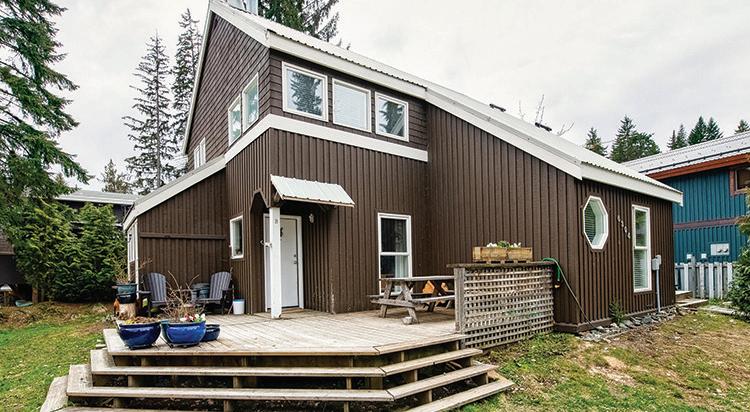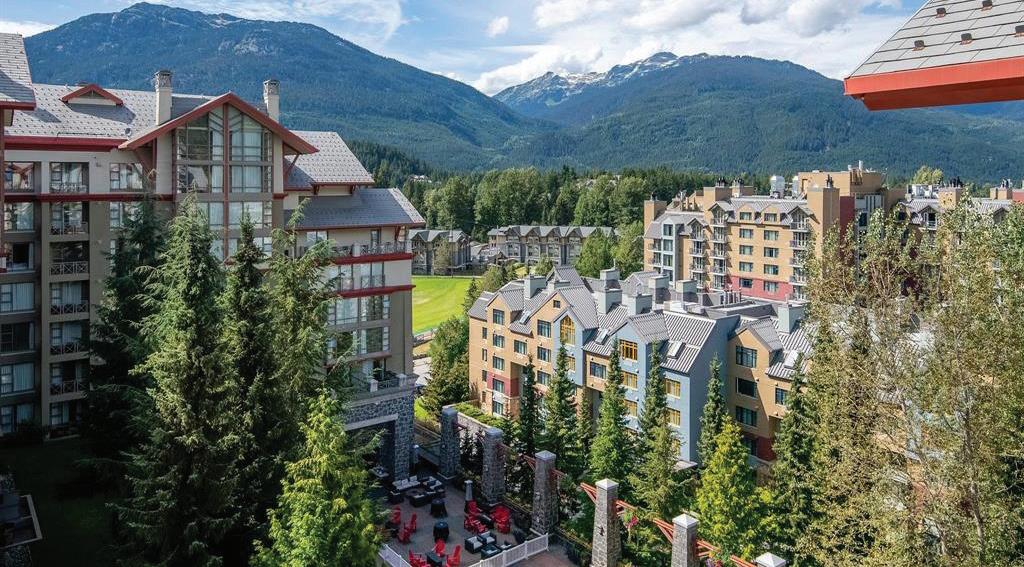




























































arts are passionate about connecting


plant

SHOP









inside


with the healing power
Through their high-quality

and commitment
they aim
inspire health
Their vision promotes
safe, herbal practices that



















a deeper
and
with the plant

A 2018-2022 Whistler council retrospective. - By Braden Dupuis

14 ON TRACK Whistler Blackcomb’s Creekside Gondola and Red Chair replacement project is on schedule for completion by opening day on Nov. 24, according to COO Geoff Buchheister.
Local builders are applauding a bylaw update that will cut red tape at municipal hall and reduce waiting times for permits.
23 STEP BY STEP Lil’wat Nation Chief Dean Nelson talks reconciliation, land purchases, Indigenous knowledge and more in a Q&A with Pique
Advocates are proposing an
alternate route for the last linkage of the Sea to Sky Trail. But will the Squamish-Lillooet Regional District approve?
donation to Alpine Canada from a part-time Whistler resident spells good news for Canada’s elite alpine athletes.

62 HOUSE AND HOME A new HGTV show filmed in
Whistler, featuring designer Sarah Richardson, is set to premiere on Oct. 19.

COVER Dear mayor and council, sorry about the timing. I don’t think you’re turkeys. But YOU try putting
job and I apologize that Rick
Morty
influence
together!? Thank you for doing your best
an otherwise































































































#202 -1390 ALPHA LAKE RD., FUNCTION JUNCTION, WHISTLER, B.C. V8E 0H9. PH: (604) 938-0202 FAX: (604) 938-0201 www.piquenewsmagazine.com

Founding Publishers KATHY & BOB BARNETT
Publisher SARAH STROTHER - sstrother@wplpmedia.com
Editor BRADEN DUPUIS - bdupuis@piquenewsmagazine.com
Sales Manager SUSAN HUTCHINSON - shutchinson@wplpmedia.com
Production Manager AMIR SHAHRESTANI - ashahrestani@wplpmedia.com
Art Director JON PARRIS - jparris@wplpmedia.com
TESSA SWEENEY - tsweeney@wplpmedia.com
GEORGIA BUTLER - gbutler@wplpmedia.com
Digital/Sales Coordinator AMELA DIZDARIC - traffic@wplpmedia.com
Production production@piquenewsmagazine.com
Features Editor BRANDON BARRETT - bbarrett@piquenewsmagazine.com
Arts Editor ALYSSA NOEL - arts@piquenewsmagazine.com
Social Media Editor MEGAN LALONDE - mlalonde@piquenewsmagazine.com
BRANDON BARRETT - bbarrett@piquenewsmagazine.com
MEGAN LALONDE - mlalonde@piquenewsmagazine.com
ALYSSA NOEL arts@piquenewsmagazine.com
ROBERT WISLA - rwisla@piquenewsmagazine.com
Classifieds and Reception mail@piquenewsmagazine.com
Office and Accounts Manager HEIDI RODE hrode@wplpmedia.com
Contributors G.D. MAXWELL, GLENDA BARTOSH, FEET BANKS, LESLIE ANTHONY, ANDREW MITCHELL, ALISON TAYLOR, VINCE SHULEY, LISA RICHARDSON

President, Whistler Publishing LP
SARAH STROTHER - sstrother@wplpmedia.com
ISSN #1206-2022
Subscriptions: $76.70/yr. within Canada, $136.60/yr. courier within Canada. $605.80/ yr. courier to USA.

included. GST Reg. #R139517908. Canadian Publications Mail Product Sales Agreement #40016549.
OPENING REMARKS Truth and Reconciliation is much more than just a catchphrase and a day off, writes editor Braden Dupuis.
LETTERS TO THE EDITOR Letter writers this week weigh in on Whistler’s housing crisis, the 2030 Games, and the role media should play in elections.
PIQUE’N YER INTEREST Snacks, poop and other ways hiking subtly prepares you for parenthood (welcome back, Alyssa Noel).
MAXED OUT As election day draws ever closer, Max weighs in on the incumbents.
RANGE ROVER Leslie Anthony delves into the world of carbon capture—akin to the technological Wild West—at Squamish’s Carbon Engineering.
FORK IN THE ROAD Be graceful, grateful, and kind as you enjoy your Whistler Thanksgiving, however you spend it.
MUSEUM MUSINGS Whistler pioneer Myrtle Philip often wore pants in an era when it was not considered acceptable for women.











































































































































































































































THERE’S A QUOTE about reconciliation, attributed to Gwawaenuk Nation Chief Robert Joseph, that Squamish Nation Councillor Khelsilem likes to share.
“He said, ‘Reconciliation is a journey, always beginning with the first step, and when that step is completed, you take the next,’” Khelsilem said, at the Squamish
BY BRADEN DUPUISLil’wat Cultural Centre’s National Day for Truth and Reconciliation event on Sept. 30.
“’The journey unfolds bit by bit, block by block. When that rhythm kicks in, you know that the process of reconciliation is underway.’”
If you had asked me 15 years ago, I wouldn’t have understood what Joseph—a residential school survivor himself—really meant with these words. But I think I get it now.
On the face of it, it’s a somewhat simple approach to a complex, challenging topic—one with no clear guidelines or rules for engagement; no right approach or prescriptive method.

The legacy of Canada’s Indian Residential School System—which, for decades, forcibly removed Indigenous children from their homes with the express intention of stamping out their culture— goes far beyond survivors, or even their children or grandchildren, Khelsilem said in his remarks.
It also plays a fundamental role in Canada’s nation-building story.
“There’s a lot to be said around the cumulative impacts of that system on our communities that we are still dealing with today,” he said. “But there is a path
that’s been laid out by leaders from our communities, survivors within our communities, around the better future that so many of our elders have wanted to create for their children and their grandchildren and their great grandchildren, and I think that that is a value that is found in cultures all around the world.”
And reconciliation has many different meanings to many different people, Khelsilem added—many different paths forward, with all of us moving at a different pace.
But, as Joseph said, every journey starts with a single step.
I will always remember the day I took mine.
It was the spring of 2011, and I was enrolled in a two-week journalism bootcamp at the First Nations University of Canada in Regina.


around the edges.
The ceremony hadn’t even begun, and I was learning.
As an elder recited prayers, we took turns smudging with sweetgrass smoke (cupping smoke from the burning grass, and “washing” our faces with it), before the men passed the pipe amongst themselves.
I sat there silently, listening to the prayers of the elder, smoke rising from our circle to the heavens.
I remember feeling both moved and humbled at being welcomed into this ancient tradition, but I also felt embarrassed, and weirdly jealous—because I suddenly realized that I had no similar connection to culture of my own.
There I sat, just another ignorant white man, devoid of culture or connection to the land or his ancestors, bumbling his way
It signaled a small but fundamental shift in my underlying psyche—and the first step on my own personal journey of reconciliation.

It is a journey that continues today.
As SLCC curator Alison Pascal wrote in a recent letter to Pique, Truth and Reconciliation is not a one-day-a-year affair. This publication is not perfect on that front, nor am I. We all have our blind spots. Part of reconciliation is admitting that, and when we need to do better.
Part of it is understanding that all of this is so much more than just a catchphrase and a day off—it’s a long and winding uphill road that we’re all walking together, whether we know it or not. There will be setbacks and detours along the way, but that’s OK, as long as we stay committed to listening and learning as we go.
As Khelsilem said, reconciliation means
One day, I was invited to take part in a traditional pipe ceremony. Having no idea what that was, or why it was important, I was hesitant at first. But I said yes.
Ushered into the First Nations Veterans Memorial Teepee—a beautiful glass, indoor structure at the university—I chose a spot near an Indigenous friend on the outside of the circle, immediately showing my ignorance. She laughed at me playfully, pointing out that, in pipe ceremonies, the men sit in a circle on the inside of the teepee, while the women sit in a circle
through a charmed and privileged life.
And then I just felt sort of empty and sad.
I didn’t know it at the time, but looking back on it now, that was my first real “reconciliation moment”—the realization that I truly didn’t know what I didn’t know, and maybe never would. All I could do was keep trying.
It was such a beautiful, solemn and timeless thing that I was invited into there, after growing up surrounded by—and sometimes, ashamedly, participating in— casual racism.
different things to different people.
To me, it’s less of a concrete, quantifiable concept and more a state of mind—an acceptance of my own shortcomings, and a willingness to slow down and listen.

If you haven’t begun your own journey yet, that’s OK, too. There’s no time like the present, and you can start by asking yourself a simple question: do you know what you don’t know?
Go ahead, ask it—you might be surprised (and possibly completely overwhelmed) by the answer.


Let’s talk staff housing again!
Sorry, but so many people are looking at or talking about it, I feel it’s an important discussion for everyone living and working in Whistler if we want Whistler to survive and keep its name on top as a world-class ski resort.

These kids are coming for a season, but oops, we forgot to tell them there’s no staff housing, or maybe you could couch-surf for a few weeks till you overstay your welcome. I had a couple of employees telling me about their housing situation: one rented an old sauna and another stayed in a garden shed (of course, it was insulated). What the hell? No wonder so many young kids are struggling with mental health issues.
Most businesses in Whistler are feeling the stress of another winter season with very little staff, or business owners stepping up to work 12- to 16-hour days with no day off. Some are doing a shorter work week and others are leaving town, never to return.
We would love to buy housing for our staff, but $3-million-plus is a little out of our reach, and again, half the homes in Whistler are empty or used two months of the year.

I know the municipality is trying. Why can’t they build a large hostel, or maybe invest in staff housing similar to the mountain, or modular homes to try to keep the rent reasonable.
I know this subject has been around for years, but it’s just gotten worse with increased demand for homes in the mountains.
Bring back the soul of Whistler, or it could be RIP to my lovely resort town.
I love my wee town.
Wendy Wheeler // WhistlerAt Whistler’s all-candidates meeting on Wednesday, Sept. 28, there was a question asking if the candidates supported the 2030 Olympic bid. Nearly all the candidates said yes. I was amazed. What were they basing their decision on? Information on a 2030 bid is hard to come by. There is little solid information available, and
yet there will be a decision made in Mumbai next June. (I guess this means funding a delegation to Mumbai as well if we go ahead.)
In July, Vancouver city staff recommended council hold off on a decision on a potential bid for the 2030 Olympics, because there are so many unknowns, largely related to the costs to prepare and host another Winter Games. Government involvement at all levels was unknown and uncommitted with insufficient time and staff to work on this. Read more at council.vancouver.ca.
Prior to Whistler’s 2010 agreement to become part of that bid, there were several public forums where presentations were made and questions were asked. Have we seen anything like that? I answered a telephone survey about 2030 in which the questions were

pre-worded and the answers given as a range of satisfaction. At the end, I was allowed a comment reinterpreted by the survey taker. Not what I consider public input.
Security costs for 2010 were US$1 billion, according to CBC News. With the addition of Sun Peaks, there are now three locations instead of two as in 2010—what will security cost? Multiple billions? There is no legacy from this cost—it’s up in smoke the day the Games end.


There are so many worthwhile areas to focus on funding these days—we all know the obvious, but maybe that’s because they’re important. Why not cut to the chase and use the funds now, instead of ending up with some narrowly focused legacy projects after the party is over?
In January 2022, in the Vancouver Sun, Douglas Todd wrote: “2030 Winter Olympics a hard sell for British Columbians … Questions simmer about finances, the housing and opioid crises, the pandemic and how much the Games would contribute to reconciliation.”

He also questions whether increased tourism is a viable argument. In Whistler, we are currently not coping with our own success, so we may risk our reputation if our current state of affairs continues.
Prior to the 2010 Olympics, I volunteered at the Olympic information centre in the village for two years; I packed athlete welcome packages; I was a Weasel Worker at the pre-Olympic downhill. During the Games, I housed out-oftown volunteers, and I worked the whole Games with the Canadian team in the Cheakamus Olympic Village. There was more. I saw the Olympic Games from the inside out.
The Olympic Games in its current format is a financially unsustainable extravaganza. By removing our support, the IOC may begin to see that it cannot continue this way. There is not a good enough argument for spending an unknown amount of taxpayer funding on a festival that is in dire need of major restructuring.
Do you want a council with this agenda? Not much choice after their near-unanimous
don’t know who these people are, you shouldn’t vote at all, because you are disrespecting the people who made the effort to find out and skewing the outcome.
Lyall Fetherstonhaugh // Whistler


(Editor’s note: Like most media outlets, Pique employs both reporters and columnists, who serve different roles. Reporters report the news in a fair, unbiased way. Columnists share
JINNY“Yes” on Sept. 28. But be vocal if you don’t want to go along with this bid process. And let’s get some information available. The decision will have to be soon.
 Jinny Ladner // Whistler
Jinny Ladner // Whistler



I just want to start off this letter by saying that Pique Newsmagazine is one of the best smalltown newspapers around. However, something that has happened every municipal election is causing me some concern.
This is a certain columnist’s articles that endorse municipal candidates for election. I find this to be highly unfair to both the candidates and the voting public. The media‘s job is to report—to inform us, the public, of what is going on—not trying to influence our decisions.
The CBC is an excellent example of this. Publicly funded, they do not shy away from reporting on anything Prime Minister Justin Trudeau does, from going to surf at Tofino instead of being at the Kamloops residential school for the first National Day for Truth and Reconciliation or getting highly-paid speaking engagements for family members at the WE charity. Also reporting that Conservative leader Pierre Poilievre aligns himself with the freedom convoy, and opposes COVID vaccination policies. Those are facts which the voters use to then determine who to vote for. The CBC has never endorsed candidates for election.
For Glacier Media, however, to publish articles that endorses candidates is corruption—or it could be construed that way. Because what happens when some of the endorsed candidates get elected? Nothing’s for nothing in this world, so do those people owe Glacier Media or the columnist that wrote the article something? Inside info, perhaps?
I’m pretty sure there’s nothing monetary happening here, because in the hood this columnist lives in, a Maserati in the driveway would kind of stick out.
It’s the responsibility of the voters to find out who the people are running for office, and then cast a vote based on their research. If you
their personal opinions, which quite often include insights about politicians and their effectiveness—but don’t necessarily reflect the views of this publication).

I’ve been keenly watching the Valley Trial saga unfold in these pages over the last few weeks: electric bikes, speedsters, dogs off leash and so on. I’m a regular commuter on the trail with my old road bike that can go at a damn good clip. It’s transportation, and gets me to the village from the west side of Alta Lake faster than my car (by the way, kudos to Whistler Transit for announcing that they plan to one day bring transit back to Alta Lake Road after 11 years of zero service).
The Valley Trail is also a transportation route. And while bicyclists speeding recklessly can be a problem (electric or muscle-powered), the issue is not all about speed. My biggest close calls have been with pedestrians walking five abreast across the trail, completely unaware that they’re walking on a transportation corridor. My $10 bell works wonders to clear the way, and my brakes are in good shape for when it doesn’t, but blocking the entire trail is a problem.
There has been much talk about keeping dogs on leashes, too. My closest calls with dogs on the Valley Trail have been with those on leash—human on one side of the trail, dog on leash on the other side.
I think what we need to keep the Valley Trail amenable to commuters, recreationalists and tourist wanderers is some simple educational signs. “This is a commuter trail, please keep to the right,” or “Enjoy your stroll, but please keep to the right. Bikers en route to work!”
My point being: don’t demonize the speeders. Educate everyone about the multiuse aspect of the Valley Trail. It’s one of the best things going in this town, and to get so many people out of their cars and onto their bikes (electric or not) is a great thing.
Stephen Vogler // Whistler n

“The Olympic Games
its
is











HISTORICALLY, I’VE GONE a little wild when the snow disappears from the alpine.
I would spend weekdays in the summer researching local trails, choosing a hike to tackle that weekend, and roping a few people into coming along.
 BY ALYSSA NOEL
BY ALYSSA NOEL
It comes down to basic math: if you’re lucky, you have a mere 12 to 15 weekends a year to hit the trails at higher elevations. Factor in weddings, trips, visits with family, work obligations, and you’re looking at eight to 10.
Then add a baby to that mix—like I did last summer—and your number dwindles to more like four or five.
I might not get out as often anymore (though bless my Osprey Poco baby backpack for the times I do), but this summer, I realized those years of wandering aimlessly—and a little frantically—around the mountains have actually equipped me with some excellent lessons for parenthood.
How is that, you ask? Well, here you have it:
Carry snacks. Always have snacks. Too many snacks. A variety of snacks. Like a tiny, tottering toddler, hikers quickly get hangry and snacks are an easy solution to curb a meltdown.
Bring spare clothes. News alert: kids shit themselves. More specifically, they seem to have the uncanny ability to craft a massive, up-the-back blowout when you didn’t bring a fresh outfit. If you heed the advice of the 10 essentials—which include extra clothes in case of an emergency—you avoid the shitstorm.


Be prepared for poop. Speaking of shit, hiking—perhaps, more specifically, backpacking—sometimes requires you to think outside the box, bathroom-wise. You have to know how to hide your unseemly squat from other hikers, handle your waste in an environmentally friendly manner, and keep it sanitary. Well, guess who is fresh off changing a blowout in the passenger seat of a car in a ferry lineup, just as that lineup started loading? This hiker.
Embrace exhaustion. I am no expert hiker or endurance athlete, but, in the past, I’ve managed to power through 20- to 30-kilometre hikes with just under 2,000 metres elevation in a day. Add to that a nice Backcountry Widowmaker at the end
of the day, and you have yourself a great night’s sleep. With a newborn, you might not actually get any sleep, but pushing through exhaustion is something hikers are pretty good at. In fact, if you really want to make this comparison work, you could draw a parallel between triumphantly standing on a mountain peak with your wobbly Jell-O legs,
swallow it so that it’s part of you always?


(Uh oh, just me?) I’ve felt this way about the millions of magical parenting moments I’ve experienced over the last 15 months. When my daughter leans in for a kiss or throws her arms around me or dissolves into fits of laughter, I want to consume the moment and keep it visceral and vivid forever. Which leads to…
and staring at your baby’s sweet, milk-drunk face at 3 a.m. in a dimly lit nursery. Both feel pretty great, emotionally, if not physically.
Soak up the moment. I’ve tried to articulate this more than once and I always wind up sounding insane, but have you ever hiked to a mind-blowing, take-your-breathaway destination and been overcome with the desire to consume it? It’s so euphorically stunning you want to not just capture it, but
Accept that the moment is fleeting. On backpacking trips, my favourite time is the morning, after you’ve retrieved your bear-hung bag, brewed coffee, and can just sit with your camp cup in hand, taking in your surroundings. Most of the time while hiking, you reach your destination, have something to eat, take a few photos and turn right around again. The joy of it is so fleeting it’s almost painful. Guess what else you stare longingly at in the rearview mirror as it clips by before you fully process it? One hint: it goes from crawling to walking to running before you can finish this sentence. But, in a way, that’s part of the magic. Both hiking and parenting force you to live as wholly as you can in the moment, appreciating it for what it is. Because in the end, it all dissolves into fuzzy, faded memories that make up the happiest days of your life. ■
“[I]f you’re lucky, you have a mere 12 to 15 weekends a year to hit the trails...”
WITH LESS THAN TWO months to go before ski and snowboard season begins, Whistler Blackcomb COO Geoff Buchheister has some good news for locals.
The Creekside Gondola and Red Chair replacement project is “on track” for opening day, he said. Helicopter pilots have been taking advantage of the unseasonably warm, dry, early fall weather to install towers for both lifts, Buchheister explained, and “once we get those in, the next phases are on track.”
In the meantime, Whistler Blackcomb staff are “working with the manufacturer to make sure that the remaining items show up on time,” he added. “There’s a stretch of work to finish out here, and we’re working very hard, but [opening day is] the goalpost that we’re aiming for.”
In September of last year, Whistler Blackcomb parent company Vail Resorts announced plans to replace the previous six-seater Creekside Gondola with a new high-speed, eight-person gondola, while simultaneously swapping out the Big Red Express quad for a new high-speed, sixperson chair.
According to Whistler Blackcomb, once finished, the upgrades are expected to increase Creekside’s out-of-base capacity by 35 per cent and Big Red by 30 per cent— all in an effort to limit wait times and improve the overall guest experience.
Whistler Blackcomb announces upgrades to Jersey Cream, Fitzsimmons chairs
Before those new lifts get spinning, Whistler Blackcomb had another surprise announcement in store for guests: the resort announced last Wednesday, Sept.
speed chair, increasing uphill capacity by a whopping 73 per cent in winter. The upgrade will also be “a year-round investment,” said Buchheister, by majorly reducing liftline waits and increasing capacity for the Whistler Mountain Bike Park.
Meanwhile, in the Jersey Cream zone, a new high-speed six-pack will replace the high-speed quad that is among the most popular lifts on Blackcomb Mountain. The move will increase uphill capacity by 29 per cent, also reducing lift-line wait times, and
“We feel like that mid-mountain section is now quite tended to, and we can start thinking about the future after these improvements are in.”
The brand-new lifts were originally earmarked for Vail Resorts’ Park City property in Utah, but were stalled by permitting delays.
28 that two more of its chairlifts, Whistler Mountain’s Fitzsimmons Express and Blackcomb’s Jersey Cream Express, are set to be replaced next year. The upgrades are subject to approval, the company cautioned, but are scheduled to be installed in summer 2023. When construction wraps up, that will amount to six new lifts in five years for Whistler Blackcomb since the Blackcomb Gondola and new Emerald Express opened in 2018.
According to Vail Resorts, the existing four-person Fitzsimmons chair located at the Whistler Village base will be replaced with an eight-person, high-
improving circulation, Buchheister noted.
“We’ve been investing in infrastructure on the mountain, and focused, as I like to call it, in a strategic way,” said Buchheister. That focus has been on “moving people out of the valley as efficiently and effectively as we can,” and improving circulation in the mid-mountain zone, he added.
“We’re in Whistler, and we have storm days,” he said. “We really want to tend to the circulation on days when not everything’s open, and then provide those points of transit and [make it easier to move] from one part of the mountain to the other on days when everything is open.
More specifically, the project was shot down in June after the Park City Planning Commission revoked a permit approval for the two lift upgrades, siding with a group of locals who opposed the project, as the Colorado Sun reported. The locals argued the project would increase capacity at the ski area without a more thorough plan for improved parking. In a tweet following the decision, Park City Mountain Resort said its lift plans had been “shockingly blocked,” adding, “chairlift tourism, or the idea that modernizing lifts will draw more crowds, does not exist.” Whistler’s Ecosign Mountain Resort Planners were consultants on the project and agreed improved chairlift capacity “does not directly cause an increase in business or demand,” as per the Sun
“We’re excited about the opportunity that we have by having the right profile to put these lifts in, because … there are specifics to it,” said Buchheister. “But we’re excited about the opportunity to go after an eight-pack and a new six-pack, and know and feel confident that those will be additives to the experience.”
Plus, both Fitzsimmons and Jersey Cream were on Whistler Blackcomb’s list of lifts due for replacement in the “near future,” he added. “So the decision we
“We feel like that mid-mountain section is now quite tended to, and we can start thinking about the future after these improvements are in.”
- GEOFF BUCHHEISTER
had to make really was, ‘Are we ready to pull that forward?’ And you know, after contemplating it all, we realized that this was a true opportunity and we needed to take advantage of it.”
As Vail Resorts spokesperson Sara Roston clarified in a follow-up email: “Park City remains committed to pursuing permitting for upgrades, and when they resolve the permit with the city, they’ll move forward in the process to procure lifts and equipment needed for installation. In the meantime, the original lifts are being deployed to WB, which, as Geoff shared, we are excited about.”
Whistler Blackcomb’s new lift announcement came the same day Vail Resorts released an update on its 2022 fiscal year (FY), which ended July 31. The company listed its total net revenue as US$2.5 billion in 2022, representing a 32.3-per-cent (and $616 million) increase from the year prior, and its net income as $347.9 million for FY 2022, compared to $127.9 million the previous year. “The increase is primarily due to the greater impact of COVID-19 and related limitations and restrictions on results in the prior year,” the report explained.
It also said pass sales for the 2022-23 ski season through Sept. 23, 2022 were up by six per cent in units compared to the same period one year prior.
Acknowledging the effects the Fitz construction in particular will have on bike park operations, Buchheister said Whistler Blackcomb is working on “a plan that has the least amount of impact on the bike park as possible,” and ensures the park “remains as close to fully open as we can get, with the exception of a few construction dates here and there that may impact certain
trails—a lot like what happened this year with Creekside,” he explained.
Those effects will be minimized by focusing early construction on the Fitz Chair’s bottom terminal in April and May, opening about 15 kilometres of new trails— including a new jump line—in Creekside, serviced by the new gondola, and moving all sightseeing operations to the Blackcomb base so the Whistler Village Gondola can be “100-per-cent” focused on biking, said Buchheister.
“Biking is very important to us and we’re going to be very focused on delivering for our bike guests,” he said.
“We’re optimistic about the future. We know that there will always be challenges and unintended consequences, especially when you take these kind of ambitious projects, but we also know we’re a team that can deliver the experience around it, and we’re ready to adapt and overcome and we’re really stoked to do it.”

Not everyone, however, is as excited about the upgrades as the COO.
Whistler Blackcomb guest Ken Bell launched a Leadnow petition last week to “Protest Vail Resorts [sic] Decision to replace Whistler Blackcomb’s Fitzsimmons Chair with 8 person lift.”
As Bell posited in the campaign’s description, the “shortsighted” decision was made without user consultation. But the main problem, in Bell’s view, is that the Fitzsimmons Express deposits guests at the bottom of a four-person lift that is not being similarly upgraded. “Guess what the backlog is going to be like on the weekends, holidays and powder days at the Garbanzo chair?” Bell wrote.
The petition currently has 34 signatures.
Whistler Blackcomb will close for mountain biking and sightseeing this year on Monday, Oct. 10. The resort is scheduled to reopen for winter operations on Thursday, Nov. 24. n
Deluxe King suite lock off apartment
2 bathrooms, kitchen, fireplace at
popular Hilton Whistler. Generate income



unlimited owner use
the freedom to come and enjoy Whistler as much as you want including in room dining, shuttle ser vice, ski valet, pool and spa, sports bar and more!
WHISTLER’S THIRD all-candidates meeting ahead of election day gave voters the most fulsome view yet into their platforms, with the slate of 18 council and mayoral hopefuls fielding questions from the three host organizations, the public—and each other.
Co-hosted by Arts Whistler, the Whistler Chamber of Commerce and Pique Newsmagazine, the event drew a sizable crowd to the Maury Young Arts Centre—at least for the first half of the evening.
To begin the night, each of the 15 council hopefuls had one minute to address the audience, an opportunity most candidates used to rehash their platforms and preferred talking points.
Find a recording of the entire threehour event here: vimeo.com/event/2213328.
The real substance came during the question-and-answer period, with each
host organization asking a question to a handful of chosen candidates. Housing was a recurring topic, as is usually the case in Whistler, and several candidates touched on how interconnected the issue is to the resort’s other persisting challenges.
In response to a question asking what specific ideas they had to help Whistler’s young working class, each of the candidates asked touched on the need to solve the resort’s housing crisis first and foremost.
“I commend the mayor and council for their worker security work that they’ve done through the Whistler Housing Association (WHA), but we need a different kind of housing for entrance-level workers,” Rhonda Millikin responded. “We need gapyear students in dorm-type housing and we need cross-generational housing to address the crisis in well-being that Whistler Community Services has documented.”
Curtis Lapadat answered next, saying one of the first things he’d do if elected is pursue federal housing funds. He also promised to ensure the 36-unit, three-storey, residentrestricted rental apartment slated for White Gold “gets approved pretty quickly”—a rezoning bylaw for the project received first
and second reading at this week’s council meeting, nearly five years after it was first proposed. The electrical engineer also said he would “extend another loan to the [Whistler Development Corporation] to start doing some more development.”
The final candidate to answer was Gordon Jeffrey, who believes Whistler needs “to be willing to admit that we have a real [housing] crisis” to the province in order to access muchneeded housing grants. He also promised to “fight for more housing by incentivizing Airbnb operators to offer housing to more locals,” as well as offering free transit and parking passes to local employees so “they have less bills to worry about and they’re more empowered in these times.”
For years, the Sea to Sky has been making the case to the provincial powers that be for a regional transit network that would better connect Mount Currie and Pemberton to the rest of the corridor, and beyond.
In response to a question asking what ideas he would have to fund a regional
transit network, council candidate Jeff Murl said it’s all about advocacy.
“Advocacy is a big component of what I’ve been doing for the boards I’ve sat on, and I’m really excited to work at another level, to head to that provincial level and see if I can make a difference there, because I think we do have to make a difference,” he said.
Those that stuck around to catch the back half of the meeting at the Maury Young Arts Centre were eager to hear more specifics from the resort’s trio of mayoral candidates: Marcus Culver, Brian Walker and incumbent Jack Crompton.
“You’re scrutinized and in the public eye, but I don’t feel like you’re answering questions directly this evening,” said one attendee when she took to the microphone. “I think we are lacking specifics when people are asking for solutions. You’re not providing them. You’re talking about past actions or


















[being] generic, and people want solutions.”
The demand for detailed policy plans came up a handful of times at the Sept. 28 forum, a clear sign of the electorate’s frustration with the vague promises and pie-in-the-sky ideas coming from some of the candidates.
With the comparatively smaller field vying for the mayor’s chair compared to the 15 hopefuls bidding for one of six spots on council, it allowed for more time to gain insights into each of the candidates’ respective platforms—or lack thereof.
In what was perhaps a signal that many local voters have already made up their mind for mayor, the sizable crowd that was initially on-hand to hear from prospective councillors earlier in the night had dwindled significantly by the time the mayoral hopefuls took to the stage.
Whistler Chamber of Commerce board chair Diana Chan was pointed in her question to the trio of candidates, asking more than once for specific ideas that would support the economic sustainability of local businesses.
“It’s easy to say motherhood and apple pie. Many of our local businesses have had to be resilient, have had to be creative on the fly solving issues from labour, to supply chain issues, to commercial rent and tax increases,” she said. “This is a community,
the business community, that understands how to be specific and how to take action.”
A soft-spoken Culver went first, noting how transportation, and particularly mitigating Whistler’s growing traffic congestion, would help.
“We’re dealing with huge congestion, which I’m sure most people here know,” he said. “We need some serious transportation options. There’s some task force already working on that and along with [council candidate] Brendan Ladner, so potentially, maybe having valley gondola service, maybe having some more passenger rail. I’d like to brainstorm other ideas on that one.”
Next up was Crompton, who touched on a number of challenges facing the business community. On the topic of lengthy permitting times at municipal hall, which local building firms have chalked up, in part, to reams of unnecessary red tape, Crompton pointed to a council directive passed the day prior that would refer “a bunch of the decisions that would come to the council table to staff, and that will really improve things,” he said.
The incumbent also highlighted David Eby’s “ambitious” housing platform in his bid for leader of the B.C. NDP, just rolled out last week, that Crompton has discussed with Eby’s team. (See related story on page 26.)
The former housing minister’s plan— which proposes a range of expansive changes to B.C.’s housing landscape, including legalizing secondary suites, increasing density in community areas zoned for single-
family homes, and a new “flipping tax” that would be applied to sales of residential properties that are resold within two years— would “create a huge amount of money being made available to local governments,” Crompton said. “And that’s something we’ve been advocating for.”
Walker answered last, and rehashed one of the main tenets of his campaign: creating an accreditation training system he has dubbed the Whistler Service Guild for local workers that would connect them to interested employers.
“What that does is accredit people for any position that they’re employed in town so that employers can go on to say, a website, the Whistler Service Guild website, and see who has been credited as a dishpig or a waiter, general manager of a restaurant, general manager of a hotel, and the more accreditations that you acquire, the more valuable you are to businesses in town,” he explained. “Think of it like the Girl Guides and the Boy Scouts meet the service industry.”
Not all of the questions at Wednesday’s meeting centred on policy. Several questions from the community were more about personality and communication style, signifying voters want more than just good legislation at municipal hall, but good governance, too.
In one heated question, a community member asked how the prospective mayors
intend to “actually interface with the public you’re meant to be serving.”


Crompton highlighted a council he believes has been “very available” to the public during their term—including Crompton himself handing out his personal phone number, which he listed again for those in attendance. He also spoke to the sometimes combative nature of community dialogue that has taken place locally as swaths of the resort have grown increasingly frustrated with a number of pressing issues.
“I’m tired of beating up on each other. I don’t think it’s helpful to our community. I’m proud of us. I’m proud of how well we take care of this place, the buildings we build, the organizations that we run,” he said.
Walker was last, and waxed poetic about the vital need to listen to your constituents.
“As a talkative six-year-old, my father sat me down one day and said, ‘You have two ears and one mouth because you’re supposed to listen twice as much as you talk.’ So that led to a great revelation in my life: You have to listen to what people say,” he said. “You have to process what they say. You have to give them respect for what they say. And then use that as a way to be able to do something, get things done—but listening is most important.”
Advance voting takes place in Whistler on Saturday, Oct. 8 from 8 a.m. to 8 p.m. at the Whistler Public Library.


Election day is Saturday, Oct. 15. Polls are open from 8 a.m. to 8 p.m. at Myrtle Philip Community School. n



























 BY ROBERT WISLA
BY ROBERT WISLA
LOCAL BUILDERS are applauding an update to the Resort Municipality of Whistler (RMOW) land-use procedures and fees bylaw designed to reduce red tape at municipal hall.
Given first three readings on Sept. 20 and adopted on Oct. 4, the proposed bylaw will streamline the permitting approval process by delegating some decision-making authority to RMOW staff. In alignment with the new Official Community Plan, the update will also establish precise development approval information requirements for zoning amendments, development permits (DP) and temporary-use permits (TUPs).
“The process efficiencies will result in cost and staff time savings,” said RMOW manager of development planning Melissa Laidlaw in a report to council on Sept. 20.
“So it’s not just planning staff, but you have to consider all the staff that are involved in attendance at a council meeting, preparing the package, preparing the minutes, so it’s just cost and staff time-saving.”

The bylaw changes are profound, as far as municipal land-use policy goes, and designed to lighten the planning department’s
workload. For example, the bylaw will change how minor development variance permits (DVP) are issued from something that requires a council resolution to a simple staff decision.
Chris Addario, president of the Sea to Sky Home Builders Association, welcomed the new bylaw, and attempts by the RMOW to streamline the permitting process.
“Generally, from what I see, this bylaw is a good thing, because it’s spreading some of the workloads across different members in the planning department. There’s still senior staff that these things are assigned to, but they’re taking a lot of this off,” Addario said.
“What they’re trying to do is streamline some of these things and not necessarily have to go to council all the time to make decisions. And, as well, move some of the decision-making around the planning department, which would make sense.
“Anything that helps streamline the process is going to help. Delays cost money.”
Following the COVID-19 pandemic and subsequent ransomware attack in 2021, the RMOW has been dealing with an ongoing permitting backlog which has increased the time it takes to get shovels in the ground on new projects. According to local builders, it can take months to get approvals under Whistler’s current permitting process.
That is partly because under the current
model, RMOW staff must bring all DP and DVP applications before council, each of which comes with a report that can vary considerably in size and complexity.
The RMOW estimates that, on average, between 20 and 40 hours of staff time will be saved for each delegated DP and DVP, as staff will also save time not having to create a report to bring to council.
that can be delegated—things such as building setbacks, tandem parking, and building height regulations.
Developer Rod Nadeau, founder of Innovation Building Group, also welcomed the changes.
“They’re basically catching up to what other municipalities do,” he said. “I mean, the fact that you need a variance for a setback for a post for your deck, that staff has to do a whole report to council is a complete waste of time ... It should actually be dealt with at the staff level.”
In addition to the permitting process changes, the bylaw includes a $2,400 application fee for non-delegated TUPs based on the estimated average amount of staff time it takes to process such a permit.
The updated bylaw is made possible thanks to last year’s amendments to the provincial Municipal Affairs Statutes Amendment Act, which the provincial government designed to improve municipal approval processes and enable local governments to delegate decisions on minor DVPs to staff.
The updated bylaw also defines what constitutes a minor development variance
The RMOW will also do a full review of the fee structure associated with permitting and development services, a change intended to improve transparency around how much permitting fees will cost applicants and better reflect the cost recovery of the permitting process.
“We are enthusiastic about opportunities to improve our permitting process,” said Mayor Jack Crompton.
“This is a super exciting move for our community, and we look forward to speeding up the process.” n

“Anything that helps streamline the process is going to help.”
- CHRIS ADDARIO



























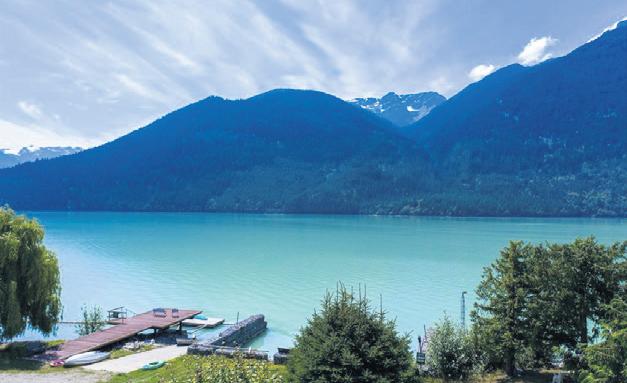

















LIL’WAT NATION Skalulmecw
Chief Dean Nelson exudes an almost preternatural calm. But beneath that relaxed exterior is, at times, a simmering frustration whenever he begins discussing the injustices his Mount Currie community has and continues to face.
The frustration is understandable. The elected political chief has been urging for a deeper understanding of the historical context of the Lil’wat for years now, and he has looked on as the Nation has been forced into the unenviable position of having to decide between forking over tens of thousands of dollars to buy back pieces of traditional land that were stolen from it by settlers, or risk losing them forever to eager developers.
But it’s not all doom and gloom, either. The Lil’wat has, in recent years, begun to truly leverage the power it gained, in part, through the legacy land swap tied to the 2010 Olympics, and has seen its budget expand by leaps and bounds with each passing year—its 2023 budget tops out at more than $43 million, roughly 25-per-cent higher than last year—leading to a flurry of new projects, including a new transition home expected for completion this year, a

$2.4-million renovation of its Istken Lane townhouse development, slated for next year, and an expansion of the Xet ’ ólacw Community School completed this summer.
Pique caught up with Nelson via email for a wide-ranging conversation on Truth and Reconciliation, better integrating the Lil’wat into decision-making in Whistler, and Indigenous knowledge in the schools.

The following conversation has been lightly edited for length and clarity.

It has been a year since Canada’s first National Day for Truth and Reconciliation. Generally speaking, how do you think the Sea to Sky and Canada as a whole has done to advance reconciliation?
DEAN NELSON: In the Sea to Sky corridor, I feel there is a general enquiry of wanting to understand what reconciliation truly means, but also I feel there is some reluctance to acknowledge the full impact or vastness of what has occurred in the history of the Indigenous people with the general public.
Do you feel that attitudes among nonIndigenous people in the corridor have shifted in how they think about Canada’s history of colonialism,
residential schools, and the harm that has been done to the Indigenous population?
I feel the cold, hard truth was revealed with the findings and the testimony of the children that did not return home from residential schools. I feel there remains a lot of general public processing of the scale of what took place, if this is indeed their introduction to Truth and Reconciliation. If this is the introduction, there has to be more.
Take the Reconciliation Day to fully understand why this day is framed as such. What is your truth and understanding? Is my understanding congruent to what is being shared? What are the inherent rights of Indigenous people prior to contact?
How do you feel about the fact that the Lil’wat has had to buy back its own land from settlers?
We have been buying back lands mainly adjacent to the reserve when opportunity arises that has history of the Lil’wat on them. We need to secure them from further complications of new owners, developers from occupying them before we have an opportunity to address wrongful transactional occurrences. I feel it is very essential that we secure all lands when we have the opportunity to address unethical transactions through a historical, ethnocentric process.
The RMOW and Sea to Sky corridor initially need to understand the history of the lands and the original people’s values before contact and the pre-monetary period. And

There’s been a lot of talk about hiring more Lil’wat to help shore up Whistler’s staff shortages. What do you think needs to happen for Whistler to hire more Lil’wat? How can employers best welcome Lil’wat members into the fold?






There must be effort to undertake Lil’wat people as employees. There must be

Young students need to learn where the Lil’wat people lived in the immediate area and why they were moved off the lands. The children need to know basically what happened in local history. The children need to know where the Lil’wat are today: on the reservation, under the Indian Act. The children need to know where the Lil’wat are trying to get to as far as language, culture, and traditional living. There will be further questions stemming from the conversations. The answers that are given to the children is what we will base our future on.
How do we ensure reconciliation with the Lil’wat is meaningful, and not just a hollow promise?
why the original inhabitants were removed from the land they so dearly cherished as it was. People ask, what do I need to know? If people really want to know, they should take the time to hear the full history from a reliable source. One thing I recommend to people about the Truth and Reconciliation Day is to take that day to further understand what occurred, what are your truths as told to you. There has to be a willingness to undertake full understanding.
commitment to see this through fully, within reason. There is a lot of interactive work that we all need to undertake, understand and communicate.
We’ve spoken before about incorporating more Lil’wat history and knowledge into school curriculum in the Sea to Sky. What do you hope young students in the corridor learn about the Lil’wat?
We need to see positive, concrete changes on the ground. Reconciliation is positive change and understanding to do what needs to be done to fulfil positive change, or undo what is wrong to correct the wrongs and [gain a] full understanding of it.
On Oct. 7 at 1 p.m., the Lil’wat are hosting a ceremony to celebrate the official transfer of a parcel of its traditional Upper Valley lands, formerly the Coast Mountain Outdoor School (CMOS), which was donated to the Nation at no cost. The ceremony will take place at the former CMOS schoolhouse across from the Lillooet River Bridge, about 20 kilometres east of Pemberton. All are invited to attend. n

How do you think the Resort Municipality of Whistler (RMOW), and by extension Whistler, can better integrate the Lil’wat into decision-making?
“We need to see positive, concrete changes on the ground. Reconciliation is positive change and understanding to do what needs to be done to fulfil positive change...”
- DEAN NELSON

 BY BRANDON BARRETT
BY BRANDON BARRETT
JACK CROMPTON talks to a lot of mayors around B.C., and to a person, they usually tell him the same thing.
“Every single one of them tells me housing is their community’s No. 1 issue,” he said.
That’s part of the reason why Whistler’s mayor welcomed David Eby’s wide-ranging affordable housing plan rolled out last week, as the former housing minister throws his hat in the ring for leadership of the B.C. NDP.
“I’m very much supportive of the ambitions in the plan. I think it’s important to say that the details need to be worked out, but it’s bold,” said Crompton, who was asked to share his thoughts on the plan with Eby’s campaign staff prior to its release. “These proposals demonstrate a seriousness and an urgency I think British Columbians and Whistlerites want government to bring to housing. It’s a message that the same old approach isn’t working.”
There are a number of strategies in the proposal that could have a major impact on Whistler’s strained housing market, but for the mayor’s money, it’s Eby’s promised $500


million in capital funding to jump-start rental housing acquisition so that non-profits can purchase affordable rental buildings listed for sale, which would protect tenants already living there from displacement, that he is “most enthusiastic about.”
Crompton was also in favour of the proposed creation of BC Builds, a housing development initiative aimed at expanding
financing is attractive,” Crompton added.







Eby’s plan would also legalize secondary suites in communities across the province, which some critics have warned could force greater density in municipalities that don’t necessarily want it. For Whistler, however, Crompton said fully allowing secondary suites is one way to address the need for more worker accommodation.


seems to generate, hasn’t seen much uptake from homeowners.
“One of the projects in our workplan is to review and potentially expand the infill housing program. These provincial changes will have a lot to say to that work,” Crompton noted.
Another bold measure from Eby’s proposal is a so-called “flipping tax” that would apply to the residential properties that are resold within two years of purchase.
“It’s hard to know until we see the details, but I certainly don’t think flipping houses serves Whistler’s worker housing needs,” Crompton said.
 - JACK CROMPTON
- JACK CROMPTON
the province’s role in creating middle-class homes by partnering with First Nations, local governments, non-profits and private partners to offer rapid approvals, increased density, and construction financing. According to Eby’s plan, BC Builds would use public land to eliminate the cost of land acquisition, and lock in low interest rates for long-term affordable housing projects.
“In a high-interest world, low-cost



Another measure Eby put forward to increase density is to allow neighbourhoods focused on single-family homes to add up to three units to a lot, which housing analysts have said could put pressure on wealthy areas to not exclude renters through disallowing things like basement suites and laneway houses. It’s similar in philosophy to Whistler’s infill housing policy—which, for all the discussion it
Being a campaign platform, Whistler’s mayor was hopeful Eby keeps the promises within his affordable housing plan if he is indeed elected as the NDP’s new leader.
“It’s difficult to say I endorse this policy because, at this point, it’s a campaign proposal rather than a policy that is going to face the house. For it to gain endorsement by me or by our organization would require it to become legislation,” explained Crompton. “But I hope the policy details are just as bold as the campaign promises.”
Eby stepped down as B.C.’s housing minister in July to run for leadership of the party. The NDP has said voting will begin next month, with the results announced on Dec. 3. n
“I hope the policy details are just as bold as the campaign promises.”









IN TOURISM WHISTLER president and CEO Barrett Fisher’s experience, “the tourism industry can often be seen as a bubble—we’re insulated from global conflict.”

But amid the volatility of a changing climate and a growing recognition of ongoing inequities present across society, industry stakeholders have, as of late, sparked serious conversations with their communities, industry partners and with themselves, Fisher added.

“Some of those conversations have been about how can we make a difference? What are our values and our beliefs? Can we be part of a solution, and can tourism truly be a force for good?” she said.
Those were just a few of the questions Tourism Whistler posed during its firstever Whistler Cultural Symposium, held at the Squamish Lil’wat Cultural Centre (SLCC) from Oct. 2 to 4.
Tourism Whistler invited roughly 100 writers, activists, tourism officials, politicians and business leaders from Whistler, the Lower Mainland and further afield to attend the “gathering of the minds,” as Fisher called it, which featured



powerful, thought-provoking talks and panel discussions addressing a wide range of topical issues



The connection between reconciliation and tourism weaved into discussions throughout the day, but at no point was it more obviously at the forefront than during the final panel, titled “Reconcili-Action.”
Together with moderator Kiana Alexander Hill, lead executive officer at The Raven Institute, panellists Debbie Olsen (a freelance journalist), Cecilia Point (director of finance and operations for the Indigenous Tourism Association of Canada), Heather Paul (SLCC executive director), and—by way of Paul’s impromptu invitation to join her onstage—Georgina Dan (an SLCC cultural ambassador and member of Lil’wat Nation), talked at length about what reconciliation means to them, both personally and within the parameters of tourism. The women contemplated how Indigenous tourism could function as a tool to bring about positive change in the relationship between First Nations and non-Indigenous Canadians, for instance, by providing opportunities for public education and personal transformation; properly compensating individuals for sharing their knowledge and personal experiences; and above all, “listening and
learning,” as Dan phrased it.
During their own Q-and-A-style panel on Monday morning, Whistler Blackcomb chief operating officer Geoff Buchheister and Whistler Mayor Jack Crompton were frank about how their respective organizations are working to limit their environmental footprints; address diversity, equity and inclusion; and promote reconciliation with the communities on whose unceded territories they operate. Whistler Blackcomb’s “Epic for Everyone” program and the RMOW’s collaboration exploring an Indigenous-led bid for the 2030 Winter Olympics were offered as examples.
The heavy weight of those topics was balanced with a healthy dose of optimism, illustrated by panellists’ innovative ideas and attendees’ willingness to ask tough questions, demonstrating a collective desire to do better.
One Q-and-A session that struck a slightly less optimistic tone was the midafternoon “Destination Resilience.” Neither moderator Leslie Anthony, a biologist and journalist (and Pique columnist), nor panellists Arthur De Jong, a municipal councillor and self-proclaimed climate warrior, and Claire Ruddy, executive director of Whistler’s environmental nonprofit AWARE, could sugarcoat the dire
risks posed by dwindling biodiversity, a changing climate and insufficient action to address it. The inevitability of wildfire being one, they agreed.
Especially since, as Anthony pointed out, the symposium itself was taking place on yet another dry, sunny October day where temperatures hit an unseasonably warm 26.2 degrees C, about 11 degrees warmer than the average high in Whistler for Oct. 3.
Throughout the meandering conversation, panellists and those in attendance didn’t ignore the elephant in the room: in light of the tourism industry’s environmental impacts, is it even ethical to promote travel in the first place?
Still, Ruddy and De Jong managed to offer a little hope for attendees, highlighting some of the progress Whistler has already made and the many actions that could still stand to make a difference.
“We live in contradictions,” De Jong acknowledged. “I’ve felt that ever since 1993. There are a lot of good things about tourism, and people in this room know it deeply, for mental health, physical health, social connectedness … economics, the understanding of each other in the world—I could go on and on, but no, we should not stop tourism, but we need to do tourism different.” n

THOUGH RESORT TOWNS like Whistler are known to have higher-thanaverage costs of living, higher price tags are something all Canadians—including Whistlerites like Riley McSkimming—are continuing to encounter on grocery shelves amid soaring inflation.

McSkimming decided to start tracking her two-person household’s spending back in 2019 to get a clearer picture of her finances. “I just felt like I made OK money, and I didn’t know where my money went,” she explained.

All-in, McSkimming found her household’s combined food costs—including groceries, restaurants, takeout, coffee and alcohol—rose approximately 14 per cent from 2019 to 2020, and 9.6 per cent from 2020 to 2021 (though McSkimming attributes that hike, at least in part, to loosening COVID19 restrictions, less time spent at home and more money spent dining out). According to her calculations, they’re projected to rise about 5.2 per cent this year.
McSkimming’s figures aren’t too far off from national data.
According to Statistics Canada, the


inflation rate hit seven per cent year-overyear in August, cooling down slightly after reaching 7.6 per cent in July.
Grocery prices, however, continued to climb in August. They rose 10.8 per cent in a one-year period, the fastest pace for rising food costs Canada has seen since 1981.
The upward trend doesn’t look like it’s going to stop anytime soon, either. Canada’s Food Price Report 2022—compiled annually by researchers from Dalhousie University, the University of Guelph, the University of Saskatchewan and the University of British Columbia—forecasts an overall food price increase of five- to seven-per-cent for the coming year.
The report predicts that an average family of four will pay up to $14,767.36 for food in the coming year, an increase of up to $966.08 from the total annual cost in 2021. Food price increases in British Columbia will likely rise above the national average, researchers added.
Those rising prices continue to be impacted by multiple factors, Statistics Canada explained, including extreme weather, higher input costs, Russia’s invasion of Ukraine, and supply chain disruptions.
The Whistler Food Bank is one organization that is seeing the impacts of rising food costs more than most, but not
only for the reasons you might think.
About 95 per cent of the food provided by the food bank is purchased, not donated non-perishables. Thanks to partnerships with local grocery stores, the food bank is also able to purchase its inventory directly from suppliers and supplement its stock with food recovery pickups from grocers.
Pre-COVID, the food bank would see about 200 visits a month, on average. “Now, it’s 800 to 1,000,” she said.
Those visitors are also dropping by more regularly, she added. Though the majority of clients still access the food bank one to three times annually, a bigger portion of people need the assistance on an ongoing basis, said Kaya.
“We are seeing a constant increase in need that doesn’t seem to go down,” she said. “We kept thinking maybe things will be better for people, but really the housing situation is not helping.”
Kaya said more than half of food bank visitors are currently spending more than 50 per cent of their income on housing. For most, that means they don’t have enough funds left over to cover food, transportation and other bills.
The biggest challenge “is not specifically the cost of the items per se, but the increase in food insecurity in the community due to financial constraints has increased the number of people visiting the food bank,” said Gizem Kaya, food security and community development manager for the Whistler Community Services Society (WCSS), which operates the local food bank.
Despite the rising demand, the food bank has experienced a drop-off in donations over the past few months. “After two years of giving, a bit of a donor fatigue is settling in and people might be going [on] vacations and travelling, so whatever extra money they had, it’s being spent potentially on other things that they haven’t been able to spend money on, which is totally understandable,” Kaya explained. “I think it’s been anticipated in the fundraising world.” n
p o st a n d b e a m m o u n t a i n h o m e i n c l u d i n g a 1 5 b e d s u i te a b ove a 3 b ay h e ate d g a ra g e i s re a d y fo r yo u a n d yo u r fa m i l y to e n j oy Lo c ate d i n Wh i st l e r ’s p re st i g i o u s n e i g h b o u r h o o d o f G re e n L a ke E st ate s / N i c k l a u s N o r t h G o l f Co u r s e, 8 0 6 0 N i c k l a u s N o r t h B l vd i s fo r t h e d i s ce r n i n g b u ye r w h o a p p re c i ate s q u a l i t y c ra f t s m a n s h i p a n d l o c at i o n Th i s i m m a c u l ate h o m e s i t s j u st a c ro ss t h e 1 st h o l e te e b oxe s a n d o n l y a few ste p s away f ro m t h e i co n i c N i c k l a u s N o r t h C l u b h o u s e F ro m yo u r d o o r ste p yo u h ave a cce ss to p i c t u re s q u e G re e n L a ke, Lo st L a ke B i ke / XC S k i Tra i l s , Va l l ey Tra i l , Wh i st l e r A i r fl o at p l a n e d o c k , R i ve r o f G o l d e n D re a m s , a n d a n awa rd w i n n i n g J a c k N i c k l a u s d e s i g n e d g o l f co u r s e Zo n e d fo r n i g h t l y re n t a l s t h i s h o m e o ffe r s t h e fl ex i b i l i t y to g e n e
n u e
e fe
ovate
i


u re s i t s ow n p r i vate h o t t u b, st a i n l e ss ste e l a p p l i a n ce s , g a s fi re p l a ce (st rat a fe e i n c l u d e s g a s) , s m a r t h o m e e q u i p m e n t fo r co nve n i e n t h o st i n g ( l o c k , t h e r m o st at s a n d l i g h t s) , n ew fl o o r i n g , n ew co u n te r to p s , a n d s o m u c h m o re # 2 0 S u n p at h co m e s f u l l y t u r n key a n d re a d y fo r yo u to u s e p e r s o n a l l y o r co n t i n u e e n j oy i n g t h e reve n u e S u n p at h i s a q u i e t , exce p t i o n a l l y we l l m a n a g e d co m p l ex a n d l o c ate d i n t h e h e a r t o f Wh i st l e r Vi l l a g e, h a s i t s ow n h e ate d s a l t wate r p o o l a n d co m m o n h o t t u b, s e c u re u n d e rg ro u n d p a r k i n g w i t h p l e n t y o f s p o t s fo r g u e st s B e st 2 b e d ro o m i nve st m e n t p ro p e r t y i n Wh i st l e r Vi l l a g e !

“We are seeing a constant increase in need that doesn’t seem to go down.”
- GIZEM KAYA
Heating your home with gas is less than half the cost of oil or propane, 2 so you’ll reduce your monthly energy bills Plus , we’ve got rebates .
A lot of the energy used in an average home goes towards space heating you can significantly reduce your environmental footprint by replacing oil
propane heating with cleaner burning gas
Enjoy cosy fires at the flick of a switch , heat during power outages and efficient water heating

Installing a ser vice line and meter typically takes less than a day, and we’ll restore your proper ty af ter wards .
Scan the code to compare the cost of gas with other energy choices.
Learn more and apply at fortisbc.com/upgradetogas or call us at 1-888-224-2710 for help.

LOCAL MUSHROOM picker Veronica Woodruff didn’t always appreciate fungi.
“The first time I went mushroom picking, I came from Ontario, so I’m like a classic mycophobe, where it was like, ‘Don’t even look at a mushroom. Don’t touch that or you’ll get poisoned,’” she recalled.
That first time, a friend had invited her to go hunt for pine mushrooms, which she considered strange given her outsized fear of the things. “Don’t you know mushrooms can kill you?” she thought. But something flipped on that initial trip up the Duffey the moment she spotted her first pine mushroom.
“It was instant, like, ‘Oh, I never knew this part of nature existed,’” she said.
It was through her involvement with the Whistler Naturalists and their annual Fungus Among Us festival, which returns Oct. 14 and 15, that Woodruff’s curiosity bloomed into something more.
“It was the start-up of Fungus Among Us and listening to [author and noted B.C. mushroom expert] Andy MacKinnon talk about the top 10 mushrooms you should
know. It was really neat. It was like, ‘OK, I can do this,’” Woodruff said. “It’s a bit of a progression to go from a mycophobe to where I am today.”
Fungus Among Us has been turning mycophobes into mushroom connoisseurs for 20 years now, and the fungi fun continues next weekend with expert talks, guided nature walks and mushroom displays.
The festivities kick off at the Legends Hotel in Creekside on Friday, Oct. 14 at 7 p.m. with “Talks with Gurus,” a variety of short talks, featuring Thom O’Dell, discussing why mushrooms are important, and Woodruff herself, who will be presenting on local mushrooms you should know. Among some of her favourites are the dead man’s foot, a large mushroom in the puffball family that she described as a “toddler’s dream of sludge” because, if you step on them at certain times of year, “it’s like stepping onto a gooey, orange paint can.” Then there’s the eyelash cup, a small mushroom that is easy to miss but resplendent in its delicate beauty when examined under a hand lens, and another gooey fungus that is most definitely Halloween-appropriate: the bloody mushroom, a stunning white fungus that

appears to ooze blood when wet.
“You start to learn about these species of fungi that have the most interesting life histories, the way that they connect to the forest,” Woodruff said. “I love the [author and UBC professor] Suzanne Simard quote from her TED Talk where she says under every footstep is like 1,000 kilometres of mycelium—between a single footstep in the woods. It’s astounding.”
The “Walks with Gurus” sets off at 8:45 a.m. on Saturday, Oct. 15, where some of B.C.’s leading mycologists will head up a mushroom tour throughout Whistler. New this year, ticket holders will receive instructions prior to the event on which trailhead to meet their expert at, as opposed to meeting at Myrtle Philip Community School, as in past years. Limited tickets are still available.
Then, mushroom pickers will show off their finds at Legends Hotel with a mushroom display from 2:40 to 4 p.m., with the fungal treasures labelled and explained by the experts. Tickets are not required, and entry is by donation.
For the past few weeks, the Whistler Naturalists have been running The Fantastic Fungi Photo Contest, with prizes for the top photos in such categories as
Captivating Colour, Weird and Wonderful and Tiny Toadstools. There are also draw prizes for anyone who submits in all five categories. Photos must be taken in Whistler since Sept. 12, and the deadline for submissions is Oct. 12 at 5 p.m. Details at whistlernaturalists.ca/fungi-photo-contest.
A big part of Fungus Among Us in recent years has been its educational component in local schools, with experts visiting students across the corridor in the week leading up to the festival. Experts take students outside for an introduction to the world of mushrooms, and this year, will be visiting the Xet ’ ólacw Community School in Mount Currie for the first time.
“I think for some kids, this is their thing, and maybe there are classroom teachers that don’t have the mushroom knowledge our scientists do, so it’s about giving those keen kids an opportunity, and kids who don’t know much, hopefully opening their eyes to the magic of mushrooms,” said the Whistler Naturalists’ Kristina Swerhun. “Life wouldn’t be possible without mushrooms and fungi.”
For more information and tickets, visit whistlernaturalists.ca/fungus-among-usmushroom-festival. n

to




people behind
by real life
local



WHISTLER IS CONTINUING its steady climb out of the financial depths wrought by COVID.
According to the Resort Municipality of Whistler’s (RMOW) Q2 financial report, presented to mayor and council on Sept. 20, the RMOW continues to experience a strong recovery from the COVID-19 pandemic, with revenues increasing thanks to a rebounding tourism sector.
“In the tourism economy, recovery has been stronger than we expected. MRDT revenue has been incredibly strong, exceeding expectations,” said RMOW director of finance Carlee Price in a presentation to council.
Resort Municipality Initiative (RMI) and Municipal and Regional District Tax (MRDT, also known as the hotel tax) funds were both up in Q2, and represented $5,128,916 in combined revenue—a 318-per-cent year-over-year increase from Q2 2021.
April, May and June 2022 all exceeded 2019 revenues, which was the previous peak. With the additional income, the RMOW has allocated more resources to visitor services
and its 2022 financial plan.
Additionally, the surge in visitors to the municipality, particularly those that come by car, has helped increase parking revenue.
In total, the RMOW brought in $78,502,560 in revenue in the first half of the year, a 12-per-cent increase over the previous year. Revenues from property taxes, user fees, permits, programs and admissions were all up compared to 2021.
While revenues were up in most of the municipality’s income sources, a few saw notable declines compared to the previous year, particularly transit, thanks to the longest transit strike in the province’s history, and investment revenue, due to changing financial market conditions.
Investment revenue brought in $557,818 so far this year compared to $811,179 in 2021, a decline of 31 per cent. Rising interest rates have affected returns across the financial sector and are partly to blame for lower returns, Price said.
“There was a sharp increase in interest rates in the first half of the year. This affected the realized value of pooled investment products that we sold during the period,” she said.
“Overall, those are still good investments when we calculate the cost of the loss of the capital against the income received on
those investments during the same period.”
Another income source that has not rebounded like other parts of the municipality is the Meadow Park Sports Centre, which has struggled with lower visitation levels.
While 2020 and 2021 visitation numbers were affected by COVID restrictions, in 2022, the bus strike, combined with staffing
total budgeted $47 million.
A few of the larger projects have been shelved or deferred to future periods, including the White Gold and Alta Vista utilities undergrounding projects and Meadow Park Sports Centre building repairs and rejuvenation projects. Together, the projects represent $8 million of planned spending.
Some of the larger construction projects in the municipality are approaching completion, such as Lost Lake Gateway Improvements and the public safety building roof replacement. Of the 146 unique approved projects in the current budget, 102 had some spending recorded against them in the first half of the year.




shortages that have led to unplanned closures for the facility, have substantially reduced visitation levels.
The RMOW has spent $35,412,256 so far this year, with corporate and community services making up the most significant chunk of expenditures at $14,607,756.
According to the report, in the first half of 2022, the municipality spent $6.6 million on municipal projects, or 14 per cent of the
The financial picture generally seems optimistic for the municipality, though rising interest rates may negatively affect future debt obligations. With tourism returning in stride in 2022, revenues are on a positive trajectory.
“Certainly, we’re in an environment of greater certainty than in the past two years, but certain things will negatively affect this community going forward—this includes inflation and other factors,” Price said.

A budget open house will take place on Dec. 1, and all are welcome to attend.

Find more info at whistler.ca/budget. n

“[W]e’re in an environment of greater certainty...”
- CARLEE PRICE






































A NEW POLICY at Whistler’s municipal hall aims to reduce unnecessary suffering of animals by banning certain rodenticides on municipal properties.
The policy, adopted by Whistler’s mayor and council on Oct. 4, applies to firstgeneration anticoagulant rodenticides such as warfarin, as well as second-generation rodenticides, going farther than the current temporary provincial ban that the Ministry of Environment enacted in July 2021.


According to environmental stewardship manager Heather Beresford, first-generation rodenticides are slowacting anticoagulants that animals can build up a resistance to, and additional doses are not very effective.
“In recent years, second-generation rodenticides have started to be more effective,” she said in a presentation to council. “They take one dose, and they kill the animal more efficiently, but at the same time, often they get out into the wild, and other animals will eat them and then suffer poisoning from them as well.”
With the new policy, the Resort Municipality of Whistler (RMOW) seeks to


reduce or eliminate unnecessary suffering of targeted wildlife, reduce the mortality from secondary animal poisonings, and eliminate the use of rodenticides on all municipal properties in tandem, as well as create a framework for integrated
getting more attention of late. Earlier this year, multiple birds of prey were found dead near Pemberton, with the cause of death believed to be rodenticides.
The RMOW’s policy works with the current pesticide use bylaw, adopted in
above and beyond just acknowledging that long-term [rodenticide] baiting isn’t effective or humane, and it’s really encouraging to see them adopt this kind of policy,” Ryan said.
“The reason so many municipalities decided to make these motions was that concerned community members were finding poisoned wildlife in their backyards and public places, including our hawks, eagles, and other types of raptors.”
Whistler joins 22 other municipalities that have adopted rodenticide bans on municipal properties, including Victoria, West Vancouver, Salmon Arm, Coquitlam, Saanich, and Richmond.
While the new policy only applies to municipal properties, the RMOW will encourage private dwellings to consider alternative measures for pest management and will be rolling out more information in 2023.
pest management that does not use rodenticides.
“There’s been growing interest, research and concern with the use of anticoagulants in pest management for many years, and we know that it causes unnecessary suffering of wildlife,” Beresford said.
The use of rodenticides—and their impact on other animals—has also been
2008. The municipality currently spends approximately $20,000 annually on pest control, and no changes to the annual budget are anticipated with the new policy.
Erin Ryan, a wild animal welfare specialist with the BC SPCA, welcomed the new policy.
“I think this is a very exciting step for the municipality of Whistler. They’ve really gone


Whistler Mayor Jack Crompton was happy to see the new pest control policy. “It’s important that we keep our programs up to date with the latest information we have,” he said. “This is one way to ensure that we’re doing the work as well as we can.”
For more information on alternative options for rodent control, visit spca.bc.ca/ urban-wildlife. n
“The reason so many municipalities decided to make these motions was that concerned community members were finding poisoned wildlife in their backyards and public places...”
- ERIN RYAN

























THE DREAM OF LINKING the entire Sea to Sky by trail—from Squamish to the shores of Anderson Lake and beyond—has been a goal of the Squamish-Lillooet Regional District (SLRD) and hiking enthusiasts alike for decades.
Now, as the final link of the Sea to Sky Trail between Pemberton and Whistler comes closer to fruition, advocates are debating the question of exactly how to connect the remaining piece from Gord’s Garden (north of Shadow Lake) to Nairn Falls Provincial Park.
The SLRD planned to build the link sometime over the next year or two, using a proposed route along Highway 99 that passes Suicide Hill, the Pemberton Speedway, a gun range and active industrial operations.
But a group of hiking enthusiasts argue that route is not an attractive option and has some safety issues, particularly crossing the Soo River and Rutherford Creek bridges. As such, the group, led by Doug Wylie, brought an alternate route proposal to the SLRD’s Sept. 28 board meeting, which, if completed, would place the trail on the east
side of the Green River to Nairn Falls.
Wylie gathered a group of hikers to do a rough survey of the potential route, and, much to their joy, they found a suitable course for a new trail. Along the route, they found long-since-abandoned logging roads in relatively good condition and topography suitable for trailbuilding.

The eastern route would follow an
of any erosion or ditching; they’ve got relatively large trees growing on and beside them,” Wylie said.
“The first seven kilometres of this is pretty standard, sort of forest service kind of routes, logging roads, but the last kilometre you’re in the park, and you’re going along the river, and you’re right beside these beautiful falls.”
A short trail bridge would have to be
has already gained the support of a few local organizations, including the Alpine Club of Canada’s (ACC) Whistler chapter.
President of the Whistler ACC Bryce Leigh supported the proposal in a letter to the SLRD.
“We believe that this route aligns with the original vision of the Sea to Sky Trail, as the route is mostly through forested land. The route was intentionally designed to avoid developed or industrial land giving users a more natural experience,” Leigh wrote.
“There are several features along the route that would provide good viewpoints overlooking the valley and the surrounding mountains. The route would have a variety of terrain, including gentle forest old road beds, low-grade switchbacks up rocky knolls, and sections adjacent to the Green River.”
Wylie hopes the proposal piques the public’s interest. So far, the SLRD has invested staff time into the current planned route, but has not spent any money on construction, opening the opportunity for the potential alternative route to go ahead.
abandoned logging road before making its way up a hill (with views of Suicide Hill) before descending to Green River, where the trail would run along the riverside with a bridge crossing over the river at Nairn Falls.
“The unique thing I thought we found here was this series of logging roads were gently sloped, smooth, with no evidence
constructed across the Green River if the route goes forward, but Wylie believes it could be built relatively cheaply if the right location is chosen. Alternatively, the trail could be pushed through to an existing bridge by the Pemberton golf courses, but this option was not reviewed by the east-side advocates.
The proposal, while in a very early form,
“There is something build-able, and so it just seemed like a shame to me to press on with a plan that had been on the drawing board for a long time without at least having a look across the river,” Wylie said.
Beginning at the Squamish waterfront and running north for 180 kilometres through the Sea to Sky corridor to D’Arcy, the Sea to Sky Trail links the Pacific Ocean in the south to the Coast Mountains to the north. n
TRAIL BLAZER The final link of the Sea to Sky Trail between Pemberton and Whistler is moving closer to completion.
“There is something build-able, and so it just seemed like a shame to me to press on with a plan that had been on the drawing board for a long time without at least having a look across the river.”
- DOUG WYLIE


















Regional District’s Area C will have two names to choose from when voting for a school trustee position this year: Rebecca Barley and Margo Vaughan.
Barley, who is seeking her fifth term as a trustee, believes that her wealth of experience on various boards representing the N’Quatqua First Nation, as well as her time on the school board, lend her a unique view into the issues.


“I’m Indigenous, and I live in my community of N’Quatqua. So that brings a whole different perspective,” Barley said. “I have a lot of history in the area and see things through a different lens.”
Barley was the first-ever status First Nations person elected as a school trustee for the Sea to Sky School District (SD48), and believes having that representation on the board is essential when making decisions, especially given the higher percentage of First Nations students in Area C.
Vaughan, meanwhile, said she hopes to bridge the gap between parents, teachers and administration in her bid for the seat.
With a son in the education system, over the last decade, Vaughan has engaged
with numerous stakeholders and believes outcomes can be improved with better engagement.


“I found that there is a big disconnect, like a complete disconnect of what parents are saying and feeling and what those that are formulating the curriculum and the strategic plans are saying,” Vaughan said.
“Since one of the roles of a trustee is to engage with the community, I feel it’s time for some real meaningful and open, honest
engagement to close this gap. The surveys once a year aren’t really cutting it.”






For Vaughan, the key issues are improving communication between teachers, parents and administration, and finding a balance between academics and social activities in the schools.
She also believes teachers must be better consulted when creating strategic plans and deciding classroom size and composition.
“I feel it’s time that we need to start
listening to the teachers and realize that they’re our most valuable source of expertise when preparing the strategic plans and deciding classroom size and composition,” she said.
“There’s been this huge focus on studies done in other countries and other cities, and not that those don’t have great value, but it’s our teachers that are rolling them out and in the trenches every day that should have a bigger role in input when preparing these plans and the curriculum.”

Vaughan has called the Sea to Sky home since 1984, when she first moved to Whistler, and has lived in the Pemberton region since 2001.
She brings a range of board and volunteer experience, including the Lillooet Lake Estates board of directors and the parental advisory committees (PAC) at Signal Hill and Pemberton Secondary School, where she currently serves as the PAC district representative.
Three school trustee positions are up for election in SD48: two in Whistler and one in Electoral Area C of the SLRD.
SD48 covers an area from Furry Creek to Anderson Lake, with 5,138 students in 15 schools. The district employs 885 staff and has a total budget of $71,844,525 as of 2022.
Election day is Oct. 15. n








MOOSE MANAGEMENT in Canada is unique compared to other wildlife management. The primary driver of most species’ decline in Canada is habitat loss and fragmentation. Yet moose enjoy the new browse that springs up after an area has been disturbed, so it’s long been thought they benefit from industrial activities like clear cutting. Because moose are widely hunted, provinces and territories are charged with managing their habitat, ensuring healthy populations and granting tags to hunters.
Although Canada hasn’t assessed moose as at-risk nationally, reports are
BY DAVID SUZUKIincreasing of their worrisome decline in many provinces. Governments cite myriad factors, include disease, climate change, parasites and habitat alteration.
“The population is, in my opinion, heading toward a crisis and if the decline isn’t stopped it could create a situation from which it may take decades to recover,” retired Ontario moose biologist Alan Bisset writes of his province. “If it gets low enough, predation and unregulated hunting could keep it from growing at all, or worse, result in local extinction.”


Since governments control the hunt, decreasing the number of seasonal hunting tags seems like a straightforward way to reduce at least one pressure moose populations face. Yet Bisset’s proposal to reduce moose tags also reveals a social
in the strongest terms, to B.C.’s drastic escalation of Limited Entry Hunts (LEH) for moose in Tŝilhqot’in territory.”

Moose decline also played a significant role in the landmark legal case between Blueberry River First Nations and the Province of B.C. in 2021, and its precedentsetting ruling. Blueberry River community members argued that moose and caribou— which they rely on for sustenance—became increasingly scarce at their usual hunting grounds in the territory in conjunction with high levels of cumulative industrial disturbance approved by the province, and that this reflected the province’s failure to uphold their treaty right to hunt.
The case brought moose habitat needs, and the impacts of industrial activity on them, into sharper focus. Research reveals that moose rely on forests for parts of their life cycle, and that clearings and roads increase hunter access, sightlines and success rates.
As Bisset observes regarding Ontario, “In essence, the numbers of tags have never regulated the kill over most of the province. The kill depended on how many moose were vulnerable and exposed to gunfire or arrows.”
Scientists called as witnesses for Blueberry River First Nations in B.C. testified that largescale forest change was having negative repercussions for moose populations.
After reviewing the evidence, the judge ruled in favour of Blueberry River, explaining: “While the Province relies on the ‘early seral forage’ created after logging to say that such disturbances benefit moose, they do not acknowledge the limiting factor created by a lack of effective winter habitat/old forest. I conclude the evidence establishes that the moose declines are

dynamic that complicates management, as he recognizes this will likely incur backlash from hunters. “Moose are being managed by hunting interests for hunting interests with little apparent concern for the future of the herd or the interests of other Ontario residents,” he writes.


Of course, many responsible hunters support strong management and protection measures. The conservation movement was initiated by hunters to ensure sufficient habitat for preferred game species. But some are also deeply invested in their right to hunt and view hunting limitations as a threat.
In fact, the right to hunt belongs to Indigenous Peoples, and they’ve been among the loudest voices calling for change recently. Many consider moose a cultural keystone species. This summer, the Tŝilhqot’in Nation in B.C. issued a news release, “condemning the B.C. government’s destructive moose harvest allocation for the Chilcotin Region in recent days and expressing its opposition,
the result of anthropogenic [humancaused] disturbances, including industrial development impacts upon habitat.”
The Blueberry River ruling set legal precedents and made clear that new governance and decision-making systems are needed to manage lands and waters in ways that uphold treaty rights and ensure wildlife abundance.
It’s time for governments to provide better management and protection for moose populations and the habitat they depend on, including stricter hunting restrictions. This won’t make everyone happy, but it will provide food security for Indigenous Peoples, benefit other wildlife and ensure healthy moose populations.
David Suzuki is a scientist, broadcaster, author and co-founder of the David Suzuki Foundation. Written with contributions from David Suzuki Foundation Boreal Project Manager Rachel Plotkin.
“The population is, in my opinion, heading towards a crisis...”
- ALAN BISSET




extended and elegantly renovated
on a 13,044 sq.ft.

lot in Whistler
in-ground hot tub, 2 screened
This updated single family
Estates.
residential
living

This bright home has access to Gordon’s Corner on the River of Golden Dreams through the large back yard!
large decks for

day sun.
entrance
private




house has an upgraded one-bedroom suite with



renovated in 2007, the house features a large living, dining and kitchen area, wood burning fireplace and heated tiles throughout the kitchen, all bathrooms, the entry hall and laundry room.
This warehouse space is in the thriving Pemberton Industrial Park. 2151 square feet of open concept

space with two over height garage doors allows you to create what need for your business.
zoning of this strata lot allows a wide variety of commercial and industrial
Bedrooms: 5 Bathrooms: 4 Square Feet:

A well maintained family home on almost 2.5 acres, an in-ground pool, and
STREET
PEMBERTON
Bedrooms: 3 Bathrooms: 2 Square Feet: 1,300
Linwood Cedar home is perfect for full time living or as your recreation property. With 3 bedrooms and 2 bathrooms plus an adorable little guest cabin and additional exterior storage you have all you need to make this your home. The large 1.84 acre lot has tons of space for parking your cars, RV and boat.
Bedrooms:
Bedrooms:
renovated,

come out of Covid the real estate market in Whistler has





the seller is not necessarily in the driver’s seat. To
out more and how to navigate the changing landscape of the



real estate market, contact me.

Bedrooms:
This desirable downhill unit enjoys unobstructed iconic views of Mt Currie, three bedrooms, flex room, generous double-car garage, ground level patio, and huge deck off the living room. Enjoy maintenance-free living while you ride the best trails, play world-class golf, and explore the Coast Mountains. GST is paid. Unit is move in ready!
Bedrooms:
This stunning home located in the sought-after Pemberton Plateau has all the luxuries you’re looking for. The functional layout boasts a sleek kitchen with butler’s pantry, large sundeck, office near the entry, the bedrooms and laundry upstairs, and a one-bedroom rental suite below.

Square Feet:




This South-facing property with head-on views of Mt Currie is ready for your dream home. With a green space buffer to the East and wide-open views to the south, this is an excellent building lot. Right from your doorstep you can enjoy the Friendship Trail/Sea to Sky Trail, soccer fields and the Pemberton mountain bike trails.





stunning 180° views with heated tile flooring, an efficient heat/air conditioning unit, a butler’s pantry, surround sound through the interior and the outside living spaces, propane range for the chef and 2 fireplaces. Includes a 2 bedroom suite that makes a great mortgage helper, home office or nanny suite.
Bedrooms:
Beautifully renovated home in The Glen within walking distance to the park, town and schools. The recent renovation includes a gorgeous new kitchen, a new main bathroom, updated ensuite, almost all new windows, blinds, paint and cozy heated floors. The 1 bed suite plus private, landscaped back yard tops it all off!
This charming home is a rare opportunity to own on a corner lot in this highly desirable White Gold neighborhood, with just a few steps to the village, the Valley Trail and Lost Lake. Large bright kitchen, a spacious living room with a wood burning stove, vaulted ceilings and plenty of room for entertaining.

Bedrooms: 1.5 Bathrooms: 1 Square Feet:
This one bedroom plus loft is nicely updated and is situated on the Main Street side of the building with a view of the mountains. Modern kitchen with granite countertops, gas fireplace and additional sleeping or living space in the
Stone Lodge owners and guests enjoy use of the year-round heated outdoor pool and hot tub and secure underground parking.

in this property.
rentals
Bedrooms:
Bathrooms:
Orion!
Square Feet:
in


construction
an award winning development
energy efficient practices. This 2 bed/

room, modern finishes and stainless


and secure state
I RECENTLY FINISHED a piece for Canadian Geographic on the burgeoning Carbon Capture Utilization and Storage (CCUS) landscape in Canada. It’s a fascinating industry and a bit of a technological Wild West, with brainy entrepreneurs, characters galore, nervousness around proprietary technology (some companies wouldn’t even talk to me),
 BY LESLIE ANTHONY
BY LESLIE ANTHONY
big promises, lots of hype, equivocal press and… not the greatest performance record.
But it won’t be like that for long. Refinement and deployment of CCUS is ramping up, driven by federal and provincial carbon pricing and promised tax credits (in related news, tax credits for carbon-capture as well as speed of implementation appeared in President Joe Biden’s bazillion-dollar Inflation Reduction Act recently passed in the U.S.).
CCUS comprises a suite of technologies that capture CO2 from high-emitting pointsources like industrial and power facilities, or directly from the atmosphere (Direct Air Capture or DAC). The captured CO2 is compressed and transported to either be permanently sequestered underground, employed in processes like Enhanced Oil Recovery (where pressurized CO2 is pumped into the ground to push remaining oil out of aging wells), or used to create products like concrete, fizzy drinks and low-carbon synthetic fuels. All of this serves to lower emissions of the processes involved. In fact, CCUS can theoretically deliver negative emissions when more carbon gets stored than what’s emitted capturing it.
My first move was to find out more about DAC at local success story Carbon Engineering (CE), a small Canadian company that has erected North America’s first viable DAC facility on the Squamish waterfront. There I found a small, fencedin area containing a low, corrugated-roof building, a few small towers, a giant fan, and plenty of piping. Several hundred metres away stands a more expansive modern building whose infrastructure identifies it as a much-enlarged and improved version of the former. From modest pilot plant to showy Innovation Centre, this dichotomy represents CE’s evolution.
CE was founded in 2009 by Harvard professor David Keith. Scouring CO2 from air was, at the time, seen as a far-fetched “moonshot,” because concentrations of the gas are 300 times lower than in the industrial sources typically used for
pittance compared to the 10 Gt/yr of removal necessary to ensure planetary warming doesn’t exceed 1.5 C by 2050. If DAC can be scaled up to contribute a projected 1 Gt/yr to this total, that leaves 9 Gt/yr to be captured and stored via other means from industries fuelled by biomass, natural gas, oil and coal. Is this even possible?
“It’s not can we,” says Guetre. “It’s will we. We have the tech to do it now. But we don’t have 30 years to invent new stuff. So the question is how do we marshal the cheapest and fastest carbon-capture processes already in use?”
Most climate thinkers believe that achieving emission reductions through less reliance on fossil fuels remains job one—but that it’s hard to see a future in which carbon-capture doesn’t play some role. Not only must we scale up all CCUS, deploy it globally, and bring it to bear
remove about one trillion tonnes of legacy CO2 from the atmosphere. We’re definitely in trouble.”
As we head outside, she notes how scaled-up DAC is the missing piece in the carbon abatement puzzle. “It’s cheaper than alternatives, almost infinitely scalable, and can capture emissions from any point in time,” she says. “In the near term, if we capture five to 10 Gt/yr the price would be around $300/tonne; but if we get that down to $100, the cost of achieving net-zero could drop from eight per cent of global GDP to half that—saving trillions.”
- LORI GUETREcarbon-capture. But Keith persisted. With $3 million in seed money (thank you Bill Gates and Calgary Flames owner Murray Edwards), he acquired a small, mothballed chemical plant on the Squamish foreshore. CE captured its first CO2 in 2015, and produced its first clean fuel in 2017.

Vice President and head of Business Development, Lori Guetre, has invited me for a walkaround, but before we don hard hats and safety vests, we settle into a boardroom for a math lesson. Globally, we release some 35 to 40 billion tonnes (gigatonnes, or Gt) of CO2 into Earth’s atmosphere annually. Currently we’re capturing only ~0.1 per cent of that—a
on building a carbon-neutral economy, notes Guetre, but also on mopping up the enormity of legacy CO2 accrued over the past 200 years, during which atmospheric concentrations increased from a livable 280 ppm that stood for six millennia, to a frightening and—as we’re experiencing— powerful 420 ppm.
Guetre harbours no illusions about the immensity of this challenge. “We’re currently adding 2 ppm per year. So if you look at the remaining carbon budget before 1.5 degrees of warming occurs, we have less than 7.5 years before crossing that threshold at 430 ppm. To get back to a ‘safe’ level of CO2—about 350 ppm—we need to
How does CE’s tech work? Clever chemistry and off-the-shelf equipment from other industrial sectors play equal parts: giant fans spin ambient air through a contactor where CO2 is captured in a chemical reaction to produce potassium carbonate, which is sent to a reactor where the carbon is transferred into calcium carbonate pellets; these go to a final unit where high heat strips off pure CO2. All reactions involve non-toxic, non-volatile chemicals in closed-loop systems where each compound is reconstituted and used again. Modularity of the system, and the ability to locate plants anywhere, mean it can be scaled up safely to take advantage of low-cost renewable energy and proximity to sequestration sites, CO2 pipelines or centres of industrial demand.
CE’s first large-scale commercial facility is being developed in west Texas with American partner 1PointFive. “We’d like this first plant to demonstrate how megatonne-scale DAC is feasible, affordable, and available,” says Guetre, of CE’s vision of fleets of 1 Mt/yr DAC facilities working alongside renewable electricity, energy efficiency and other innovations in all economic sectors to tackle the climate crisis.
That sounded like a grand idea to me.
Leslie Anthony is a biologist, writer and author of several popular books on environmental science.
“[T]he question is how do we marshal the cheapest and fastest carboncapture processes already in use?”



 BY BRADEN DUPUIS
BY BRADEN DUPUIS


ON NOV. 6, 2018, Mayor Jack Crompton stood before the podium in front of a packed house at the Maury Young Arts Centre, having just been sworn in as the new Mayor of Whistler, and laid out his vision for the resort.
“What animates me, and what I hope will animate our community going forward, is a pursuit of depth; of roots; of permanence,” Crompton said.





“I believe in the next election someone will stand in front of this community and say, ‘My name is, and I was born here, and I want you to vote for me,’ ... I think that will be an exciting day.


“I am going to work very hard for that person to be able to call this home and raise a family here.”




Crompton invoked the stories of Whistler trailblazers past and present, and laid out what he called an “extremely aggressive” agenda for council’s first 100 days.

It was a perfectly fine speech. Nostalgic and forward-looking in equal measures, and setting the proper tone for the work ahead.
But reflecting on the mayor’s words that night as council’s term comes to an end four years later, the address feels entirely of a different era—a relic from a time capsule, recovered from an alternate reality we all once lived in, where things were mostly predictable and uncomplicated by concurrent crises.
Alas.


If the mayor’s inaugural address was about setting the course, an illconceived letter to the oil and gas industry, passed by the previous council but signed by Crompton shortly after the new council’s inauguration, was the proverbial canary in the coalmine—a harbinger of the volatile, unpredictable, and downright bizarre years ahead.
“I could have chosen a better venue. I certainly should have sent a better letter,” Crompton said in a Dec. 18, 2018 interview with Pique. “As I’ve said, I regret making any guests feel unwelcome. We were tone-deaf. We do, as a resort, depend on oil and gas.”



The backlash from the letter requesting Canadian oil producers take financial responsibility for the harm their products have caused in the community was swift and brutal, but aside from a few lingering emails and social media comments (still, to this day), the outrage had mostly subsided a month later, with no visible lasting impact.
Indeed, 2019, as a whole, comes off as rather boring when viewed in the context of 2020 to ’22.




(In the interest of saving space, we’ll have to throw to the digital



“Chaos was the law of nature; Order was the dream of man.”
-American historian Henry Adams
version of this article for the finer details of a lot of what’s discussed below—find it and all of its supporting articles at piquenewsmagazine.com.)
In the early months of the year, council deliberated and passed its first budget, with a 2.9-per-cent tax increase.
For ease of reference: the 2020 tax increase was 2.8 per cent. In 2021, council considered a 4.89-per-cent increase, before opting for a 1.08-per-cent increase instead in light of COVID’s continued impacts—a move that staff warned would lead to higher taxes in future years. And in 2022, that premonition came true, when council passed a 6.72-percent increase.
In the first half of 2019 (among many other things): council completed a project to improve safety in Function Junction; granted the Whistler Off Road Cycling Association a substantial boost in Fee For Service funding; launched a campaign to persuade businesses to close their doors in the winter; considered employee housing proposals
from private developers; held a public hearing for the long-awaited Official Community Plan; adopted a new multimodal evacuation plan for emergencies like wildfire; launched a child-care planning project; and saw an early presentation on what would prove the cornerstone of the council term in Cheakamus Crossing Phase 2.
In retrospect, 2019 was a busy and fruitful year for council, with several key projects and initiatives getting their start or being completed.

But it was by no means a year of great drama or intrigue.
The predictability would bleed into the early months of 2020, which saw council exploring corrosion control for Whistler’s water; buying a property in Emerald to restore recreational access to the neighbourhood; setting a work plan for the new Strategic Planning Committee; and hiring a new Chief Administrative Officer in Virginia Cullen.

Then, March 2020 arrived to spit in our collective faces and stomp our hopes and dreams into the ground.
Late into the evening of Saturday, March 14, 2020, Crompton was still reeling from the closure of Whistler Blackcomb due to COVID-19.
In a rare late-night phone interview with Pique, the mayor called the closure “devastating.”
One can imagine what else must have been going through his mind that night, as Whistler’s economic engine was unceremoniously scrapped in the span of hours, with nothing in the way of certainty regarding the future.
For better or worse, in the coming years and decades, this council’s term will forever be painted in the light of the pandemic.
And in that dismal context, Whistler’s current mayor and council performed admirably, if imperfectly.
And aside from the inherent strangeness of being forced to conduct all public meetings on Zoom, council’s operations surprisingly continued largely as they normally would.

Case in point: on June 23, 2020, council adopted Whistler’s updated Official Community Plan—a years-long effort spanning multiple councils and countless community members and organizations.
“I think one of the most exciting things for me is how this sets us up to continue to work with the Squamish and the Lil’wat [Nations] in exciting ways going forward, and so there’s lots to do and there’s lots of exciting days ahead,” Crompton said at the time, calling the OCP a “foundational document” for Whistler.
“So, its adoption allows us to move forward on what’s most important to Whistler.”

In the second half of 2020, council heard presentations on a new dock strategy for local lakes and a new Big Moves Strategy for climate action; adopted a new Framework Agreement with local First Nations, and began the renaming process for Squaw Valley Crescent (now Chamonix Crescent); received a report on child-care in the resort; and adopted new greenhouse gas emissions reduction targets—after hearing in September 2020 that emissions rose four per cent in 2019 (a trend that would continue for the remainder of council’s term, much to the consternation of some locals).
While council affairs were mostly able to continue unabated, the pandemic threw municipal finances for a loop, leading staff to revise the budget (more than once, in fact), cutting $12.7 million in spending, and temporarily rescinding Fee For Service funding for local groups.
As usage skyrocketed, the RMOW also facilitated the relocation of the Whistler Food Bank to the Whistler Conference Centre, and adopted temporary patio bylaws to help local businesses struggling with new space limitations.

voting opportunities available to qualified electors of Sea to Sky School District Trustee Electoral Area 4 (SLRD Electoral Area C) are as follows:

School Trustee Electoral Area 4
Type of Voting Date Time Voting Place
Advance #2
(Required) Wednesday October 12, 2022 8:00 a m to 8:00 p m

Advance #2 (Additional) Wednesday October 12, 2022 5:30 p m to 8:00 p m
Pemberton & District Community Centre 7390 Cottonwood St , Pemberton
Blackwater Creek Elementary School 9667 Pemberton Portage Rd , Devine
General (Required) Saturday October 15 2022 8:00 a m to 8:00 p m Pemberton & District Community Centre
Cottonwood St Pemberton
There is no need to pre register as the registration of al qualified electors for these elections will take place at the time of voting At the time of voting you will complete an application form (available at the voting place) and make a declaration that you meet the following requirements:
To register as a Resident Elector, you must:
• be 18 years of age or older on general voting day October 15, 2022; AND
• be a Canadian citizen; AND
• be a resident of BC for at least 6 months immediately before the day of registration; AND
• be a resident of the electoral area on the day of registration; AND
• not be disqualified under the School Act or any other enactment from voting in an election and not otherwise disqualified by law
To register as a Non Resident Property Elector, you must:
• be 18 years of age or older on general voting day October 15 2022; AND be a Canadian citizen; AND
• be a resident of BC for at least 6 months immediately before the day of registration; AND be a registered owner of real property in the electoral area for at least 30 days immediately before the day of registration; AND not be entitled to register as a Resident Elector; AND
• not be disqualified under the School Act or any other enactment from voting in an election and not otherwise disqualified by law
In addition the following applies in respect of Non Resident Property Electors:
• The only persons who are registered owners of the property, either as jo nt tenants or tenants in common, are individuals who are not holding the property in trust for a corporation or another trust (no one can vote in respect of property that s owned (in whole or in part) by a corporation or trust); AND

• If more than one ind vidual is registered owner of the property only one of those indiv duals may with the written consent of the majority of the individual owners, reg ster as a Non Resident Property Elector; AND
• To register as a Non Resident Property Elector, a person must not be a Resident Elector of the same trustee electoral area or any other trustee e ectoral area of Sea to Sky School District and can only register as a Non Resident Property Elector in relation to one parcel of land in Sea to Sky School District (as a result, a person can register as an elector in only one trustee electoral area in Sea to Sky Schoo District)
In order to register at time of voting:
Resident Electors must produce 2 pieces of identification (at east one with a signature) Photo identification is not necessary The identification must prove both residency and identity
Non Resident Property E ectors must produce 2 pieces of identification (at least one with a signature) to prove identity, proof that they are entitled to register in relation to the property, and, if there is more than one owner of the property written consent from the majority of the property owners (Please contact the SLRD ahead of time for the required consent form it must be signed by a majority of the property owners Unsigned or incomplete consent forms cannot be accepted)
Qualified electors are eligible to vote by mail Up until 4:30 p m on Thursday October 13 2022 qualified electors can request a mail ballot package by submitting the following information to Chief Election
Two days after council was sworn in, in a special council meeting on Nov. 8, 2018, the new mayor and council passed three resolutions: to form a new governance committee; to launch a new Strategic Planning Committee; and to re-form the Whistler 2020 Development Corporation (WDC).
The urgency of the meeting and the content of its resolutions was more than stock-in-trade municipal governance—it was a signal that Whistler’s new council was serious about its stated priorities of housing, planning and good governance.


So… four years on, and with the local electorate preparing to pass judgment, how has council done on those three major pillars of the term?
The housing file is perhaps difficult to gauge, given the broader affordability challenges seen elsewhere in B.C. and Canada.
This council has done an admirable job of advancing new builds, both in Cheakamus Crossing Phase 2 and other areas of the municipality, and has worked productively with its subsidiaries, the WDC and Whistler Housing Authority, to increase the number of Whistlerites living in employee housing.
And yet, the housing situation in Whistler is seemingly worse than it has been in more than a decade, with scant availability and soaring prices now the norm at any given time of year.
Keeping in mind that hindsight is 20/20, could this council have, in the first years of its term, done more, policy-wise, to ensure enough housing is available and affordable for locals?
Many in our community would undoubtedly answer yes, and housing is clearly the No. 1 issue for the vast majority of Whistlerites in this election—but time will tell if our current crisis is enough to spell the end for local incumbents.
As far as planning goes, Whistler’s Strategic Planning Committee (SPC) was presumably doing good work (we have to presume, because the meetings are closed to the public) when the pandemic hit in March 2020, and the group’s focus shifted to resort recovery.
So, again, it is worth giving some leeway here in light of the circumstances.
As of the end of the term, the main result of council’s new SPC is the Balance Model Initiative, which seeks to balance the four “pillars” of Whistler’s vision: community, environment, tourism economy and sense of place.
As part of the initiative, the RMOW conducted a datadriven analysis of population and resort visitation trends, coming up with some troubling scenarios for Whistler if nothing is done to manage growth—in short, more residents, more visitors, more traffic congestion, more pronounced labour shortages.
Basically, more of all the things Whistler is already struggling with.

Our current council has done much of the legwork in terms of setting Whistler on a sustainable path—if such a path exists.
It will be up to our next mayor and council to find it.
No pressure, really—for us as voters, or the brave seven who fill the seats this fall.
And governance… well, we have a few thoughts about governance and transparency. They admittedly come with a conflicted point of view—but hear us out.
Council did strike a new committee, and it did produce a Community Engagement Review and Community Engagement Policy.
But this council also spent $28,000 suing our newspaper over standard coverage of an event that was very much in the public interest—the April 2021 ransomware attack that crippled municipal services for months and compromised thousands of people’s personal information.
The RMOW said it sued to protect the privacy of its staff.

The reasoning is beside the point. The simple fact is that this act had a chilling effect on the local press, and needlessly strained the relationship between the municipality and local journalists.
The author knowingly writes this both as someone with a vested interest in press freedom, and someone who was intimately involved in the aforementioned events.
But one must ask: is suing your local newspaper an act of good governance?
Is it in service of transparency—that obscure, apparently unattainable catchphrase spouted ad nauseam by so many candidates in the 2018 campaign—or does it fly directly in
the face of the entire, rose-tinted concept?


Food for thought as a new batch of candidates floats a new batch of catchphrases.
As described by Councillor John Grills—who is not seeking re-election in 2022 after three terms—the ransomware attack came at perhaps the most inopportune of times.
“We managed to keep the boat afloat [through COVID], and then we took another torpedo right into the hull,” Grills said in a 2021 interview with Pique
To hear it from Coun. Ralph Forsyth, the ransomware attack was almost worse than COVID itself, if only for the fact that it only impacted the municipality—while the community around it continued to expect prompt service delivery.
“The pandemic, it was like, OK, well everyone is experiencing this,” he said. “Whereas the cyber attack was like, man, it’s just us—what are we doing? How do we get out of this?”

The answer was a complete rebuild of the municipal network “from scratch or near-scratch to ensure resiliency against known future cyber threats going forward,” the municipality said in a June 14, 2021 release.
The total cost—both direct and indirect, as well as how much will be covered by insurance, and how much will fall to taxpayers—is still not known as of this writing, a full 16 months removed from the attack.
There were of course other blemishes on the term, some

& out to Creekside

this luxury cor ner unit townhome in

original Taluswood, renowned for excellent build quality Renovated
the highest specifications: kitchen with Wolf/Sub-Zero, new bathrooms, electrical, plumbing, floors (many with in-floor heat) and







cabinetry
The spacious living room with vaulted
a majestic wood fireplace, log features and an expanse of windows with large covered, private deck. Master bedroom is on a private top level with large ensuite and walk-in closet. The lower level





guest bedrooms,
bathrooms and a deck with private hot tub.
attached garage, carport and drive Common



Engel


Völkers Whistler












CHEAKAMUS CROSSING PHASE 2—100 units of housing built in Phase 2, hundreds more delivered or en route in other Whistler Housing Authority and private developer builds, and a runway for Whistler’s next council to build much more (finances permitting).
Combining Whistler’s two massive climate documents and refining emissions targets makes things simpler for Whistler’s next council, which has all the tools it needs to reverse recent trends.
OFFICIAL COMMUNITY PLAN ADOPTION—The long and winding saga of Whistler’s OCP finally came to an end halfway through the term, paving the way for new developments in town. Like…
NORTHLANDS REZONING —An “enhanced rezoning” process for 4500 Northlands took up much of the last year of council’s term, work that will continue in the years to come.
VILLAGE WASHROOMS—The $4.5-million price tag (covered entirely by Resort Municipality Initiative funding) for three new public washrooms in Whistler Village became something of a running joke during council’s term.
self-inflicted, some completely unavoidable.
The Resort Municipality of Whistler has still not advanced any substantial corrosion control measures to address the community’s corrosive water, qualities known to leech metals like lead and iron from household plumbing (remember to flush your tap until the water is cold!).
The long-promised dream of regional transit—a stated goal of many on our current council—appears to once again be dead in the water, despite the continued resuscitation efforts of officials in Whistler and the Sea to Sky.
And speaking of transit, a four-month transit strike in early 2022—while completely outside the realm of responsibility or control for local officials—created hardship on top of hardship for local residents (never an ideal scenario in an election year, regardless of who’s actually holding the prodding stick).
And for all the efforts to build more housing, the past four years have seen a substantial number of long-term locals forced from the community due to issues with affordability and availability. Whatever the cause, and whatever council might have done or not done to prevent it, that very fact represents a blemish on this council’s record.
There were no doubt more—feel free to leave them in the comments.
This is but a small glimpse into what may go down as one of the wildest, most unpredictable—but ultimately quite productive—council terms in Whistler’s history.
As we approach the word count for our little restrospective, we have yet to touch on things like: lower speed limits in residential neighbourhoods; the enhanced rezoning process for 4500 Northlands (the final decisions for which will lie
with Whistler’s next council); old-growth logging; Land Use Contracts; the White Gold undergrounding; cannabis retail; asphalt procurement; permitting backlogs; COVID-19 vaccine policy; the Alta Lake Road sewer project; or those really expensive bathrooms in the village (read about all of these topics—and many, many more—in the digital version of this article at piquenewsmagazine.com).
For all the variables thrown at them, this council admittedly completed much of what it set out to, or at the very least, made progress.
It has positioned the town nicely for whoever fills the chairs next.
With that in mind, those variables—that chaos that has so callously upended our lives again and again in recent years— has directly exacerbated all of Whistler’s very real challenges.
In the next four years, Whistler needs a council that will advance real, long-term solutions on housing policy, affordability, labour, mental health and community well-being—not to mention broader goals around the environment and sustainability—all while keeping a watchful eye on the town’s COVID-beleaguered finances.
Easy, right?
There’s no way our next council can predict and plan for every unknown or variable. All we can do is elect people who are thoughtful, patient, and reasonable about what they can accomplish, but above all else tireless in their pursuit of a better community for all of us—and not just those who can vote.
Advance voting takes place in Whistler on Saturday, Oct. 8 from 8 a.m. to 8 p.m. at the Whistler Public Library.
Election day is Saturday, Oct. 15. Polls are open from 8 a.m. to 8 p.m. at Myrtle Philip Community School.
Read more about Whistler’s local candidates online at piquenewsmagazine.com, or whistler.ca, and pick up next week’s Pique to hear from the candidates in their own words. ■
Cathy will continue to use her passion, energy and extensive community knowledge as a member of the RMOW Council to ensure Whistler continues to be a great place to live, work and do business

RMOW Board Appointments: Whistler Valley Housing Society (Chair), WCSS, WORCA, Ar ts Whistler, Whistler Museum and Archives, Audain, and One Whistler
RMOW Committees: Chair Zero Waste, Governance & Ethics and HR.

Member Festival, Events & Animation
For Council in the RMOW Municipal Elec tion
Pick up the latest issue of your favourite read in Whistler.
Are you away for the elec tion polls?
Applic ations to vote by mail available on line at whistler.c a/elec tions and in person at Municipal Hall after September 29th. VOTE!
General Voting Day: S at., Oc t. 15th at the Myr tle Philip Community School
Advance Polls: Oc tober 5th and 8th at the Whistler Public Librar y 8:00 a.m. 8:00 p.m.
Authorized by Cathy Jewett cojewett@gmail.com

We’ve got you covered.














CANADIAN SKI RACERS are celebrating after Alpine Canada received its largest-ever personal philanthropic gift last month. The $1.3-million donation from the organization’s board chair, Timothy Dattels, is intended to help ease the financial strain on Canada’s top alpine ski, para-alpine and ski cross athletes, Alpine Canada announced Sept. 28.
“I find it absolutely abhorrent that we ask our athletes to pay—in addition to the challenge of not being in school, not working full time, etc., over a long arc— $30,000 for the privilege of representing Canada at the highest level of competition,” Dattels told Pique in a phone call from Indonesia. “This gift was designed to reduce that burden by about a third over a few years—maybe three or four years—so that we can get the funding flywheel going.” Practically, it means athletes can dedicate more time and energy to training, and less to fundraising and finding sponsors. Dattels said he hopes his donation will inspire others to offer their own support.
Internationally carded athletes are eligible for a living and training allowance through Sport Canada’s Athletes Assistance Program, but that funding tops out at $1,765 per month. High-ranking athletes can potentially earn more through targeted, performance-based funding programs
like Own the Podium. Particularly in a European-centred sport like ski racing that requires extensive—and expensive—travel for North American athletes, that barely makes a dent.
“I wanted the community to see and the athletes to feel that there are people behind them; individuals who are willing to step up,” he added.
Dattels is a senior advisor to TPG Global, a private equity firm, after serving as managing partner and chairman of TPG Asia. Prior to joining the company in 2004, he served as a partner and managing director of Goldman, Sachs & Co. Originally from Caledon, Ont., Dattels was also appointed to represent Canada on the Asia-Pacific Economic Cooperation Business Advisory Council.
His connection with Whistler, however, goes back further than any of those highranking positions: before he held an MBA from Harvard Business School, he held down gigs at the Ski Boot and in the gondola barn.
Dattels first travelled to the resort during the 1976-77 winter season, or as he remembers it, “the winter of no snow.” Still, he was hooked.
Now the avid skier manages to spend the majority of winter at his Creekside cabin, located at the bottom of Dave Murray Downhill, and finds time to ski about 50 to 70 days each season. It was in Whistler during the 2010 Olympics where he met and struck up a friendship with Canadian ski racing legend Manny Osborne-Paradis.
“One thing led to another and I started understanding what their lives were like, what the challenges were like—the level of commitment, the demands, struggles, the joy, the pain of what they do,” Dattels explained.
The first athlete he personally
sponsored was Whistler’s Britt Janyk. Eventually, that grew into a much longer list of about 15—like Osborne-Paradis, MarieMichele Gagnon, Broderick Thompson, Dustin Cook and Erik Guay, to name a few—funded by a group of financiers that included Dattels and friend Mark Wiseman, among others.
Initially, “My engagement was just to try to make their life a little bit better by showing them that they had some support,” said Dattels. “And also with some people, like with Manny, I would call it a mentoring relationship for life after sport.”
The collective extended their support to Whistler Mountain Ski Club alum and current World Cup racer Brodie Seger in 2015, then a member of Alpine Canada’s development team, after OsborneParadis made the introduction. Now, Seger and Dattels will bike, hike or ski together when their availability lines up. Seger learned about Dattels’ recent donation on a team call.
It began with an update on some of the “budgetary stuff that’s been going on,” said Seger, “and honestly, there was not a whole lot of positivity off the bat.” Then, Dattels told athletes his big news.
“All of a sudden, it was a pretty quick low to high, like zero to 100,” Seger said. “It was definitely not something any of us were expecting … When he threw that number out there, I think all of us were just like, ‘Holy crap, I’ve never heard anything like this.’”
But what struck Seger most about Dattels’ announcement was an “emotional” speech he delivered to athletes about “why he cares so much about the sport, why he cares about supporting us, why he cares about sport in general.
“To me, that’s what makes the whole thing special,” Seger added.
Dattels came on board as chairman in 2019, amid a complete overhaul of Alpine Canada’s board of directors. That board recruited a new president and chief executive in Therese Brisson, stabilized Alpine Canada’s finances and launched an ambitious, five-year strategic plan that included hiring a new slate of high-performance coaches, led by Mark Tilston from the Whistler Mountain Ski Club. The main goal? “Help Canada top the medal rankings in para-alpine and ski cross and achieve a top-five finish in alpine medal rankings at the Olympic and Paralympic Winter Games by 2026.”
In the seasons since, the governing body has made strides toward that objective, while simultaneously strengthening its commitment to creating a safe sport environment. Last winter, Canada’s alpine, para-alpine, and ski cross teams earned their best results in over a decade.
“Hopefully, we’re moving into an era of higher performance, better funding, more engagement, and potentially an exciting time in ski racing,” said Dattels.
As athletes look to keep that momentum rolling into 2023, “now it’s a matter of building the consistency,” said Seger.
“It’s definitely encouraging having the support from Tim as we deal with that whole process,” he added. “I don’t think he would do something like this if he didn’t truly believe that we are ready to be the best in the world, and he doesn’t want to see something like a financial gap come in the way of that. He clearly believes in us, and we just need to believe in ourselves as well.”











LOCAL SMASHES PERSONAL BEST IN BERLIN MARATHON, FINISHES SIXTH IN XTERRA WORLD CHAMPS—ALL AFTER A LENGTHY ROAD BIKING TRIP
BY MEGAN LALONDELONGTIME WHISTLER resident Angela Shoniker is heading home this week after an action-packed, cross-continental adventure that included a multi-day road biking trip through Spain, a personal-best marathon in Germany, and, to cap it off, a sixth-place finish in her division at the XTERRA World Championships off-road triathlon in Italy. Call it an endurance hat trick?
Initially, her vacation centred solely on a girls’ bike trip, with a friend’s house in Mallorca serving as their home base, she explained.
“I just started searching out what’s happening in Europe, race-wise, after that, close to those dates,” Shoniker recalled over the phone from Albufeira, Portugal, where she was wrapping up the month




away alongside her husband Ben Thomas and their kids, Parker and Piper.

“I was like, ‘Oh, perfect, the Berlin Marathon. I think I should just sign up for that.’”

She crossed the race’s finish line on Sept. 24 in an impressive three hours, 21 minutes and 21 seconds (3:21:21), almost 24 minutes quicker than her previous personal best. It was fast enough to earn her qualification to the Boston Marathon, blowing her goal time of 3:29:59 out of the water. “I surprised myself,” she said.
Shoniker was 643rd out of 12,633 women to cross the finish line in Berlin and 73rd in her age category. A total of 34,879 runners finished the race out of the 45,527 who registered.
Just six days later, Shoniker found herself queuing up behind another starting line, this time in Lake Molveno, Italy, for the XTERRA World Championships on Oct. 1.
Shoniker booked her spot for Berlin
in May, one month before winning the women’s 45-49 age category at this year’s XTERRA Whistler off-road triathlon and earning herself a spot at the 2022 World Championships in the process. “My husband was like, ‘Well, you’ve really got to go to that, that will be amazing,’” she recalled. “I thought, ‘two weeks away from the kids is long enough,’ but he said, ‘Well, we’ll just come and meet you.’”

Shoniker finished the off-road race in 4:27:37, earning sixth place in the women’s 45-49 age category. She tackled the swim portion in 0:26:31, the bike in 2:54:55 and the run in 1:01:16—making her the fastest runner in her age division. “I was so happy,”
she said. “My goal was top 10, and I was sixth, so what can I say?”
She wasn’t the only Whistler resident racing in the World Champs, either. Also competing in Molveno was veteran local triathlete Marla Zucht, who smashed out the course in 4:24:36 to finish second in the women’s 50-54 age category, after previously winning her age category in Whistler, and Mike Meade, who Shoniker said had to pull out of the event after an unfortunate mechanical.
Having those familiar faces around helped ease Shoniker’s nerves and made the course “feel like home,” she said. “It made it, I’d say less stressful and more fun.” n















MARINE LAMOTTE, who runs the front desk at Nita Lake Lodge, is getting lucky in the best sense this Thanksgiving.
Fortunately, good friends, who also happen to share the same house and are so close to her and her husband they all consider themselves family—a small but caring family—will be making a classic Thanksgiving dinner for the four of them to
BY GLENDA BARTOSHYes, like so many people who keep the wheels turning in resort towns like Whistler, whatever holiday it is, Marine has to work that day. So having good friends close by who are also good chefs is a blessing in more ways than one.
Meanwhile, by the time this appears in pixels and in print, Karen Bowen will have had her Thanksgiving dinner more than a week ago.
Since 2012, Karen has worked at Whistler Golf Club, where she’s now the sales coordinator responsible for group bookings. Because she and her husband have Tuesdays and Wednesdays off as their “weekends,” last Tuesday they made themselves a Thanksgiving dinner using the old “divide and conquer” approach: She makes some of
THINK THANKS Be graceful, grateful, and kind as you enjoy your Whistler Thanksgiving, however you spend it.
the dishes, he does the others.
It was the “complete shebang”—mashed potatoes, stuffing, gravy, pumpkin pie and even pumpkin beer. The only twist? Since there was just the two of them, it was roast chicken instead of a turkey. Still, a meal to make memories and all the more special because they made it their own.

If you know Whistler—or any resort town—you know that big, culturally resonant holidays like Thanksgiving or Christmas or Easter have to be pretty much overlooked and reinvented by all the key workers who keep the resort going while everyone else gets to get out and play. And stuff themselves.
The retail workers running the legendary Turkey Sales for ski and sports gear, happening this year throughout the village and Creekside. The bussers and servers and chefs cooking up a storm and delivering all that food and drink. The baristas. The bakers. The brewmasters. The grocery and liquor store workers. The guys and gals who pick up all the rubbish and trash that gets knocked around, and sweep the front entryways before it’s time for the next day’s onslaught.
The front-end service staff at the Squamish Lil’wat Cultural Centre, the museum, the Audain Art Museum, the tourist info centres, tirelessly answering question after question, all the while keeping their cool and cheerful smiles.
That “overlooking”—you know, kind of forgetting or pretending it’s really not important it’s a holiday and time to get together with loved ones even though just about everyone else in your cultural circle is doing so. And that “reinventing”—you know, figuring out just how you might reinterpret the traditional traditions and
make the day feel special, fulfilling or pleasurable, even if it’s not The Real Day your Thanksgiving is happening on. Both of these strategies can go double for managers and supervisors like Marie, who often have to buck up and fill in for staff members so they get to enjoy the holiday.
Of course, it also goes double, triple, even quadruple, for front-line workers— all the police officers, doctors, nurses, firefighters and more who keep us safe and healthy 24/7. That includes paramedics, like Jean-Marc Savoie (who’s also an excellent ice climber, BTW).
At press time, Jean-Marc doesn’t know if he’s working Thanksgiving weekend. But at any time he could be one of six paramedics on duty at Whistler’s ambulance station on Lorimer Road, ready to help and transport patients to the hospital or clinic from mountain slopes or the highway, or wherever it is they’ve found themselves in health- or life-threatening situations.
Since he started full time in Whistler just last Christmas, he’s not sure how Thanksgiving might shape up at work if that’s where he ends up this year. But given the Whistler station doesn’t have a stove, maybe somebody will bring them over a turkey dinner. Hint, hint. (That’s me hinting, not Jean-Marc!) Or maybe they’ll check in with the fire department to see if they’re doing a Thanksgiving shebang at the hall.
Otherwise, Jean-Marc is more familiar with traditions at North Vancouver and Vancouver ambulance stations, where he worked for 15 years before Whistler. At Lower Mainland stations—especially the biggest ones at Surrey Memorial Hospital and the Downtown Eastside—paramedics
lucky enough to have Thanksgiving Day off often come in to the station to cook a big traditional Thanksgiving dinner for those who have to work.
All this to remind you that at the heart of any Thanksgiving lies the simple idea of gratitude.
Maybe we all had a rethink about expressing our gratitude socially, publicly, at the start of the pandemic. But there’re plenty of reasons to keep that gratitude going, especially in places like Whistler.
The Oxford Dictionary of Word Histories explains that the words “grace,” “grateful,” “gratitude” and even “gratuity” all come from the same root: the Latin gratus meaning “pleasing” or “thankful.” “Thanks” comes from the Old English thancas, the plural of thanc, which meant “kindly thought or gratitude.” Surprisingly, it’s related to the English word “think.”
Gratis , by the way, is a contraction of the Latin gratiis , meaning “as a kindness,” from gratia meaning “grace” or “kindness,” echoed in the Spanish gracias —all of it flowing from the same wellspring of pleasing or being pleased; receiving or bestowing kindness; thanking or being thanked.
So be graceful, and grateful, and kind as you enjoy your Whistler Thanksgiving, however you spend it. “Think thanks,” as the Old English might express it, and maybe even say it out loud to a worker or two you cross paths with. They’re worth it.
Glenda Bartosh is an award-winning journalist who wonders if someone at Whistler has a stove they could donate to the ambulance station. n













A PANDEMIC, A HIGHWAY washout, fires, supply chain issues, bureaucratic red tape.
Those were just a few of the challenges designer and TV personality Sarah Richardson faced renovating a luxury home in Whistler, some of which will be featured on the upcoming HGTV show Sarah’s Mountain Escape

“My takeaway? Before you buy the most expensive property you’ve ever bought, think about it a little bit,” she says. “We jumped in. We bought it on a whim and it took a lot out of us in terms of financially, stress levels, everything. It was a huge challenge.”
The daunting property featured is Haus Heidi, an eight-bedroom B&B located on Nesters Road, which according to local real estate websites sold for $3.7 million.
Richardson—a co-executive producer on the show who has had several renovation projects featured on HGTV over the years— her husband Alex Younger and their two ski-racer daughters visited Whistler back in December 2020 after their home hill was closed. Before they left, Alex told his wife he had reached out to a real estate agent, just to see if any properties might work for their next project.
“I said, ‘Why did you do that?’” she remembers. “He said, ‘I thought it would be fun for you to look at the local market.’”
After a 20-minute walkthrough, they made the leap.
Of course, one of the other major hurdles was the fact that they live in Ontario and their work was taking place in Whistler. To that end, they hired a group of locals as the team executing Richardson’s vision to create a luxury rental property, including
tagged her in Richardson’s social media callout looking for a design assistant in the Sea to Sky.
“I thought to myself, ‘Why would Sarah pick me? I just graduated, I’m so young, there’s going to be hundreds of other applicants that are more qualified for the position,’” de Boer says. “I didn’t think anything of it.”
About a week later, she told her mom and aunt about the position she didn’t
Younger were in town.
“Sarah’s design style is very bold and has a lot of layers and details, so every space in the house is really, truly unique … Every room is very unique. A lot of work went into the project picking different materials for each area and creating all the drawings. It was a really fun project. All the planning and detail that went into every space was one-of-a-kind, essentially,” de Boer says.
The continuous delays—from the municipal data breach halting work in June 2021 to various people recovering from COVID at different times (though not spread through the site)—also meant that de Boer had to push back work for her other clients when the project ran longer than expected.
“They understood,” she adds. “As the show progressed, I continued to work on my client projects. And now that the show is over, I continue to take on clients. I have my own business now.”
Whistler-based CVC Custom Builders and born-and-raised Squamish designer Ashley de Boer as the design assistant.
“It’s a great opportunity we have doing what we do and being able to share ideas and resources,” Richardson says. “Each of our artisan features is really a focus and a showcase about them and their talents and passions and what they do. I find that really exciting because it’s a hugely important part of the fabric of what makes a soulful home.”
For her part, de Boer was fresh out of school from BCIT when her neighbour
apply for. “They’re like, ‘Oh my God. Are you crazy? Go do your hair, go do your makeup and record this [audition] video.’”
Hundreds of takes later, she sent a submission in and was shocked when she heard back.
“Ultimately it was the network that decided who was going to be the design assistant and then they selected me. I still can’t believe it,” she says.
Much of the work on the project was done behind the scenes, with the crew gathering onsite when Richardson and
The first episode of the 10-part feature covers impressive ground in an hour. Viewers are introduced to the unique B&B, toured through its dated décor and watch as the bottom floor is completely transformed.
“The biggest surprise is it took longer and cost more than we ever anticipated,” Richardson says. “And we’re not novices at this. In terms of what you see, I’ve always said, ‘I don’t make reality TV; I share a realistic portrayal of the design process.’”
In keeping with the project’s theme, the premiere date for Sarah’s Mountain Escape has been delayed one week. Catch it on Oct. 19 at 9 p.m. on HGTV. n
RENOVATION NATION Designer Sarah Richardson, who renovated a Whistler home for the HGTV show, Sarah’s Mountain Escape PHOTO“Sarah’s design style is very bold and has a lot of layers and details, so every space in the house is really, truly unique.”
- ASHLEY DE BOER
WITH AN INJURED ankle and expired work visa, Whistler musician Charles Stenner had a chance to reassess.
Rather than stick around and watch everyone play in the mountains while he healed, he decided to head home to Guernsey.
“I think going home was a period for me to get some clarity on where I wanted to take my life,” he says.
He left the resort in November 2021 and spent nearly a year focusing on putting all the music he had made—alone and with other local musicians—out into the world, thanks, in part, to skills gleaned from Arts Whistler’s Creative Catalyst “band bootcamp” program.
“It doesn’t come naturally to me,” Stenner says of promotion. “It’s been growing pains. I like looking after the musical side of it. Looking after the social media is tough for me. [Having the time] did give me a kick to propel me and get it done. You just have to get started. It parallels writer’s block.”
He also managed to release a two-song, self-titled EP from Little Earthquakes, his alt-pop duo with Whistler’s Helen Hamilton.

That included the single “Let Go,” which was featured as a track of the week on BBC Guernsey, along with a radio interview. The contemplative single builds to a simple, catchy chorus marked by the lush pairing of Stenner and Hamilton’s vocals.
“I didn’t know where to start, then I made a big list of the stuff I wanted to release, including the Little Earthquakes stuff,” he says. “I was desperate to get it out. I think when I left Canada it was tough to keep the momentum of the project. I was
proud of what we’d written and recorded and I was sitting on the EP. I’m pleased we did get it out. It was well-received back home.”
On top of that, Stenner helped produce a track for Whistler indie-folk musician Ryan Harris called “Far from Home.”
“He’s doing phenomenally now,” Stenner adds. “He’s completely blown up in the time that I’ve known him … I love what he’s doing.”


Then there was the upright piano at home that he couldn’t walk by without playing. “I’ve written a few things,” he says. “I’m trying to release as much stuff as I can before I commit to recording again.”
In the end, with a new work visa secured, Stenner realized he wasn’t done with Whistler—despite the extreme challenges of housing this season (and always). Currently, he’s house sitting in Delta for saxophone player Robert Miller, but he has a promising lead on a Whistler rental.
There’s one big reason it’s worth the effort.
“The people,” he says. “Without a doubt. The beauty and the people. I’m quite a solitary person and Whistler is a pretty busy place to have to compete for peace and quiet. You can find it, but it’s becoming increasingly hard. But all of my truest friends, generally speaking, revolve around the music community—and my core group. And I’m back.”
Little Earthquakes are set to play their reunion show at the Whistler Farmers’ Market—its last of the season—on Sunday, Oct. 9 throughout the day.
“It seems like such a long time since I was in Whistler playing with Helen and everyone,” Stenner says. “It will be special.”
For more, visit facebook.com/ littleearthquakesofficial/ or instagram. com/charlesstenner. n
from the team at Coast Mountain Brewing to our community here in Whistler and throughout the Sea to Sky for supporting us amongst a stacked field of 45 breweries to win PEOPLE’S CHOICE at this year ’s Whistler Village Beer Festival!
With the win, you’ll find our beers on tap for the next year at Black’s Pub and Stonesedge Kitchen
 SHAKE
SHAKE

 BY MARY MACDONALD
BY MARY MACDONALD
THE GREAT NATURALIST Barry Lopez said, “poetry is a door anyone can walk through.” Well, here we go.
Into our ordinary lives where most of us have experienced times of confusion and loss—loss of language, voice, or loved ones— poetry is an artform that has always been a resource in times of crises and trauma.

During the pandemic, people turned to poetry in astonishing numbers. Perhaps it was our collective vulnerability—an expectation that in poetry there would be insight, support, bearing witness, help and hope. In short, when we were isolated, there was company in poetry and an expectation of truth.





The poet Mark Strand said, “You don’t read poetry for the kind of truth that passes for truth in the workaday world. You don’t read a poem to find out how to get to 24th Street.”

But we do expect a kind of moral evaluation from poets. The poet is not telling us what to do, but rather bearing witness, leading us to places we may


not have been aware of. And the poet is with us, along for the ride. Leonard Cohen called this “the responsibility of the poet—forging a connection” between poet and reader.
This year, the Whistler Writers Festival is hosting four poets who have written deeply moving collections—Sarah de Leeuw (Lot), Gillian Jerome (Nevertheless), Jónína Kirton (Standing in a River of Time), and Tolu Oloruntoba (The Junta of Happenstance).





In Lot, de Leeuw interrogates the role of language within stories of erasures and whitewashing of the geography and history of Haida Gwaii. The poems are written in couplets mirroring the two islands.
For Jerome, what is ordinary saves us. In her collection Nevertheless, she is both participant and observer with the reader in these poems, a meditation of rediscovery and reconnection with place.
Living in between her Métis and Icelandic heritage, Kirton’s poems, too, are a hybrid, part memoir and part verse. Standing in the River of Time digs deep, taking the reader through a healing journey of love, loss, and forgiveness.

Many of Oloruntoba’s poems in his


multiple award-winning debut The Junta of Happenstance are Socratic, asking questions as a way of fearlessly exploring social injustices, loneliness, love, and death.



And he does it with the most magnificent

language. Something we also come to poetry for. The deft hand of the written word.
These are poets engaged in their own truth-seeking. And in poetry, the personal grants us the key to the door of the universal, where new stories are possible.
But make no mistake, these are not sentimental poets. First there will be rivers to cross. Some rivers are raging. These poets are navigating turbulent waters with grace and courage. In the end, they are not offering solutions as much as posing questions about how poetry can build bridges and offerings of reconciliation and healing.
Mary MacDonald will moderate Poetry: Deeper Conversations—Loss, grief and finding our way home, with Sarah de Leeuw, Gillian Jerome, Jónína Kirton and Tolu Oloruntoba on Saturday, Oct. 15, at 11:30 a.m. For tickets, visit whistlerwritersfest.com.
Mary MacDonald is a writer and holds a PhD from UBC. Her book of short fiction, The Crooked Thing, is available from Caitlin Press, and locally from Armchair Books. She sits on the board of the Whistler Writers Society and is curator and moderator for poetry at the Whistler Writers Festival. Find out more at marymacdonald.ca. n
Vancouver’s Ian Wallace is an internationally known conceptual artist whose influence has spanned over five decades. His integration of painting and photography has featured in many important exhibitions locally and around Europe. Through his appointment at the Emily Carr University of Art and Design, his emphasis on the importance of art history knowledge has helped shape a generation of artists emerging from the Vancouver scene including, Jeff Wall, Stan Douglas and Rodney Graham.
The Audain Prize for the visual arts is one of Canada’s most prestigious honours. Worth $100,000, the prize is awarded to a senior artist in recognition of their outstanding contributions to the arts. Recipients of the Audain Prize are highly acclaimed Canadian cultural icons. Since 2004, the Audain Prize has been awarded to 19 of British Columbia’s leading visual artists, selected each year by an independent jury.
 Courtesy of the artist.
Courtesy of the artist.


 BY JILLIAN ROBERTS
BY JILLIAN ROBERTS
TROUSERS, SLACKS, britches, pantaloons or jodhpurs. There was a time, relatively recently, when local women were challenging societal expectations when choosing to wear pants.
Many will be familiar with the picture of Whistler’s “first lady,” Myrtle Philip, in her checkered pants with a big smile and hands on her hips. The image has been immortalized on the side of the Whistler Museum along with many posters and pamphlets. What may surprise some is how shocking it was at that time for visitors from Vancouver to see a woman wearing pants.
When Myrtle first came to Alta Lake, now known as Whistler, in 1911, there was no highway or train line, and the journey from Vancouver was a difficult three days. The first day involved catching a steamship from Vancouver to Squamish. In Squamish, Myrtle and Alex Philip picked up packhorses and then spent the next two days on foot travelling over rough terrain, climbing around boulders and fallen logs, and weaving in and out of deep gullies. The trail was barely two feet wide and seldom used, but women were still expected to traverse it in long, heavy skirts, as per the fashion and societal expectations at the time.
As most would understand, hiking, horseback riding and working outside in long skirts is not very practical. However, you could not buy pants for women. Myrtle tried various men’s pants, including overalls, but did not like them. In an oral history from 1971, Myrtle explained the solution: she would make all of her own pants. “I had a pattern and then that’s what I wore all of the time,” she said. For many of the visitors from the city, a woman wearing pants was not a regular sight and was seen

as rather scandalous by some.













Famed mountaineer Phyllis Munday, who lived in North Vancouver during this time, also had to explore her limited clothing options. Summiting more than 100 mountains during her career, including many around Whistler, she came up with a solution that ensured she did not face prejudice for wearing pants in the city. “You were never seen on the street with britches in those days, so we would wear a skirt over our britches. Then when you got to the foot of the mountain or the foot of the trail or wherever you happen to be, you took your skirt off and cast it underneath a log and there it would stay until you came down.”
Thankfully, societal expectations have changed in Whistler today, and women are not expected to ski, ride and hike in skirts and bloomers. However, this change was more recent than many people would expect. When the lifts were turning on Whistler Mountain in 1966, 55 years after Myrtle had first visited the valley, Renate Bareham lived near Myrtle on West Side Road. Between 1931 and 1976, the local school opened and closed regularly based on the fluctuating number of residents. For Renate, and many other kids in the valley, it was a long and snowy trek to get to the bus, followed by the bus ride to Squamish or Pemberton for school.

After the one-hour hike to the bus, Renate remembers, “at that time, you weren’t allowed to wear pants to school when you were a girl. So we would have to wear our pants over to the bus, then as soon as we got to school we had to change into our dresses or skirts.”
My appreciation goes out to those who challenged and continue to challenge the status quo. Thankfully things have changed, and women are not expected to ride the bike park in long dresses.


















ARIES (March 21-April 19): When you Aries folks are at your best, you are drawn to people who tell you exactly what they think, who aren’t intimidated by your high energy, and who dare to be as vigorous as you. I hope you have an array of allies like that in your sphere right now. In my astrological opinion, you especially need their kind of stimulation. It’s an excellent time to invite influences that will nudge you out of your status quo and help you glide into a new groove. Are you willing to be challenged and changed?



TAURUS (April 20-May 20): Author Toni Morrison thought that beauty was “an absolute necessity” and not “a privilege or an indulgence.” She said that “finding, incorporating, and then representing beauty is what humans do.” In her view, we can’t live without beauty “any more than we can do without dreams or oxygen.” All she said is even truer for Tauruses and Libras than the other signs. And you Bulls have an extra wrinkle: It’s optimal if at least some of the beauty in your life is useful. Your mandate is summed up well by author Anne Michaels: “Find a way to make beauty necessary; find a way to make necessity beautiful.” I hope you’ll do a lot of that in the coming weeks.
GEMINI (May 21-June 20): Philosopher Alfred North Whitehead said, “It requires a very unusual mind to make an analysis of the obvious.” I nominate you to perform that service in the coming days, both for yourself and your allies. No one will be better able than you to discern the complexities of seemingly simple situations. You will also have extraordinary power to help people appreciate and even embrace paradox. So be a crafty master of candour and transparency, Gemini. Demonstrate the benefits of being loyal to the objective evidence rather than to the easy and popular delusions. Tell the interesting truths.
CANCER (June 21-July 22): Cancerian poet Lucille Clifton sent us all an invitation: “Won’t you celebrate with me what i have shaped into a kind of life? i had no model. i made it up here on this bridge between starshine and clay, my one hand holding tight my other hand.” During October, fellow Cancerian, I propose you draw inspiration from her heroic efforts to create herself. The coming weeks will be a time when you can achieve small miracles as you bolster your roots, nourish your soulful confidence, and ripen your uniqueness.
LEO (July 23-Aug. 22): “Dear Rob the Astrologer: This morning I put extra mousse on my hair and blow-dried the hell out of it, so now it is huge and curly and impossibly irresistible. I’m wearing bright orange shoes so everyone will stare at my feet, and a blue silk blouse that is much too high-fashion to wear to work. It has princess seams and matches my eyes. I look fantastic. How could anyone of any gender resist drinking in my magnificence? I realize you’re a spiritual type and may not approve of my showmanship, but I wanted you to know that what I’m doing is a totally valid way to be a Leo. —Your Leo teacher Brooke.” Dear Brooke: Thank you for your helpful instruction! It’s true that I periodically need to loosen my tight grip on my high principles. I must be more open to appreciating life’s raw feed. I hope you will perform a similar service for everyone you encounter in the coming weeks.
VIRGO (Aug. 23-Sept. 22): How to be the best Virgo you can be during the coming weeks: 1. You must relish, not apologize for, your precise obsessions. 2. Be as nosy as you need to be to discover the core truths hidden beneath the surface. Risk asking almost too many questions in your subtle drive to know everything. 3. Help loved ones and allies shrink and heal their insecurities. 4. Generate beauty and truth through your skill at knowing what needs to be purged and shed. 5. Always have your Bullshit Detector with you. Use it liberally. 6. Keep in close touch with the conversations between your mind and body.
LIBRA (Sept. 23-Oct. 22): The Libran approach to fighting for what’s right shouldn’t involve getting into loud arguments or trying to manipulate people into





 BY ROB BREZSNY
BY ROB BREZSNY

seeing things your way. If you’re doing what you were born to do, you rely on gentler styles of persuasion. Are you doing what you were born to do? Have you become skilled at using clear, elegant language to say what you mean? Do you work in behalf of the best outcome rather than merely serving your ego? Do you try to understand why others feel the way they do, even if you disagree with their conclusions? I hope you call on these superpowers in the coming weeks. We all need you to be at the height of your potency.
SCORPIO (Oct. 23-Nov. 21): “One bad apple spoils the rest” is an idiom in the English language. It refers to the idea that if one apple rots as it rests in a pile of apples, the rest will quickly rot, too. It’s based on a scientific fact. As an apple decays, it emanates the gas ethylene, which speeds up decay in nearby apples. A variant of this idiom has recently evolved in relation to police misconduct, however. When law enforcement officials respond to such allegations, they say that a few “bad apples” in the police force aren’t representative of all the other cops. So I’m wondering which side of the metaphor is at work for you right now, Scorpio. Should you immediately expunge the bad apple in your life? Or should you critique and tolerate it? Should you worry about the possibility of contamination, or can you successfully enforce damage control? Only you know the correct answer.
SAGITTARIUS (Nov. 22-Dec. 21): Of all the signs in the zodiac, you Sagittarians know best how to have fun even when life sucks. Your daily rhythm may temporarily become a tangle of boring or annoying tasks, yet you can still summon a knack for enjoying yourself. But let me ask you this: How are your instincts for drumming up amusement when life doesn’t suck? Are you as talented at whipping up glee and inspiration when the daily rhythm is smooth and groovy? I suspect we will gather evidence to answer those questions in the coming weeks. Here’s my prediction: The good times will spur you to new heights of creating even more good times.
CAPRICORN (Dec. 22-Jan. 19): More than you might realize, people look to you for leadership and regard you as a role model. This will be extra true in the coming weeks. Your statements and actions will have an even bigger impact than usual. Your influence will ripple out far beyond your sphere. In light of these developments, which may sometimes be subtle, I encourage you to upgrade your sense of responsibility. Make sure your integrity is impeccable. Another piece of advice, too: Be an inspiring example to people without making them feel like they owe you anything.

AQUARIUS (Jan. 20-Feb. 18): Rapper-songwriter Nicki Minaj says, “You should never feel afraid to become a piece of art. It’s exhilarating.” I will go further, Aquarius. I invite you to summon ingenuity and joy in your efforts to be a work of art. The coming weeks will be an ideal time for you to tease out more of your inner beauty so that more people can benefit from it. I hope you will be dramatic and expressive about showing the world the full array of your interesting qualities. PS: Please call on the entertainment value of surprise and unpredictability.

PISCES (Feb. 19-March 20): Author Robertson Davies declared, “One learns one’s mystery at the price of one’s innocence.” It sounds poetic, but it doesn’t apply to most of you Pisceans—especially now. Here’s what I’ve concluded: The more you learn your mystery, the more innocent you become. Please note I’m using the word “innocence” in the sense defined by author Clarissa Pinkola Estés. She wrote: “Ignorance is not knowing anything and being attracted to the good. Innocence is knowing everything and still being attracted to the good.”
Homework: Reward yourself with a gift for an accomplishment few people know about. Testify: Newsletter.FreeWillAstrology.com.

In addition to this column, Rob Brezsny creates EXPANDED AUDIO HOROSCOPES



In-depth weekly forecasts designed to inspire and uplift you. To buy access, phone 1-888-499-4425. Once you’ve chosen the Block of Time you like, call 1-888-682-8777 to hear Rob’s forecasts. www.freewillastrology.com































Blackcomb Way 4205 Village Square Hours: up to 40 hours per week
$20 per hour
Free ski pass Vacation: 4% of salary

training provided



Work for a locally owned, independent ski rental company. Fun work environment, deals on equipment, and free ski pass!





























Recreation Facility Clerk
Temporary Part-Time
IT Senior Systems Specialist
Planner
Planner
Planner
Regular Full-Time
Temporary Full-Time
Temporary
IT Business Analyst
Utility Operator
Regular Full-Time
Water Distribution
Manager of Procurement
Recreation Program Leader
Temporary
Regular Full-Time
Regular Part-Time
Recreation Facility Attendant
IT Systems Specialist
Regular Part-Time
Regular Full-Time
Senior IT Business Analyst
Watch Clerk
Regular Full-Time
Regular Full-Time
Financial Services Specialist
Truck Driver Class
Utilities Technician
Custodians
Temporary
Regular

The ideal Caretaker has 20 years’ work experience with a proven track record in hospitality and or the property/building management or site management sectors. Experience and knowledge of HVAC, security systems, grounds upkeep and general maintenance is an asset.
The ideal Caretaker must be organized and flexible with an extraordinary attention to detail and sense of pride. It requires you are discreet, professional and intuitive with strong communication skills to develop positive working relationships with the principal, staff, contractors and others.
This is a full-time live-in opportunity.
Familiarity with, and long-term residency in, Whistler is an asset.
Please submit your resume via email at caretakerwhistler@gmail.com. Resumes will be received until 5pm on October 10th, 2022. Due to anticipated response, only those who will be interviewed will be contacted.









Corona

are



The Sea to Sky corridor’s top civil construction company.
are currently recruiting
Equipment Operators

Class 1 Truck Drivers
Pipe Layers




Construction Labourers

wages, extended health



Heavy
At the Liquor Distribution Branch (LDB) our vision of ‘Service. Relationships. Results.’ is all about providing a valued service, building strong relationships with our stakeholders, and achieving greater results for the province.
The LDB is one of two branches of government responsible for the cannabis and liquor industry of B.C. We operate the wholesale distribution of beverage alcohol within the province, as well as the household retail brand of BC Liquor Stores.
We employ nearly 5,000 people in over 200 communities and have been named one of BC’s Top Employers 14 times over for offering exceptional places to work rooted in values of fairness and respect, work-life balance, and inclusion and diversity. We believe that our people are our greatest asset. Being a reputable employer with programs of skills training and professional development are what attract candidates to BC Liquor Stores, while our progressive, forward-thinking culture is why employees with a growth mindset thrive.

Auxiliary positions are on-call, meaning hours of work are not guaranteed and subject to availability. Some auxiliary employees may not initially work a full 35-hour week, but with more hours worked and more seniority gained, more opportunities for more hours of work will follow.
Auxiliary positions are not permanent full-time but can lead to permanent full-time opportunities with a very competitive total compensation package, including a comprehensive pension plan, medical and dental coverage (including massage and physiotherapy), tuition reimbursement and scholarship programs, and access to public service employee benefits including career support services, financial and legal services, and employee and family counselling.
We are dedicated to the highest quality of customer service, delivered with friendliness, individual pride, initiative, and retail passion! If you fit this description and you are prepared to work in a fast-paced environment, we encourage you to apply to become a part of the Whistler area BC Liquor Stores.
To be eligible, applicants must meet the following qualification requirements:
• Be at least 19 years of age
• Be able to legally work in Canada
• Be able to provide excellent customer service
• Be able to communicate effectively and professionally with the public
• Be able to demonstrate aptitude for cashier and related duties, including calculations
• Be able to perform physically demanding work, including lifting 20-25 kg boxes
• Have a valid Serving It Right Certificate™

• A Criminal Record Check is required.
BC Liquor Store Sales Associates may be required to operate a variety of mechanical and hand-operated equipment, in addition to handling large volumes of bottles as part of the LDB’s recycling program.

Rates of Pay as of April 11, 2021: Auxiliary Sales Associate - $19.45
Seasonal
Job Location: BHLP Pemberton Base1850 Airport Road, Pemberton B.C.
Status: Full-Time Permanent Position
Blackcomb Helicopters is a well-established full service, multi-fleet helicopter company with rotary flight and maintenance services. We have bases in Squamish, Whistler, Pemberton, Sechelt, Lillooet and Vancouver.
This position will be part of the Technical Records Team working in a variety of projects such as: organization of technical records information, data input, filing, assisting the Technical Records supervisor, updating all aviation relation databases, assistance in safety initiatives, and other office duties when required.
• Above average English skills, both verbal and written;
• Experience in the aviation industry or related work a definite asset;
• Good attitude and excellent work ethic.
A self-starter.
• Detail driven your attention to detail is a source of pride for you;
• Superior knowledge of Word and Excel and able to pick up new software quickly;
• Excellent organizational skills and ability to focus on repetitive tasks;
• Great sense of humour;
• Legally entitled to work in Canada.
This is a position working Monday to Friday of 40 hours per week, however, we will require flexibility in terms of days worked as occasional weekend work may be required due to the nature of our business. We offer an excellent benefits program, RRSP, and an energetic and diverse work environment. This position does require working at our base, however, remote work from home is available on an occasional basis.
Note: Blackcomb Helicopters is federally regulated, therefore, proof of double vaccination is a condition of employment. If you are interested in this position, please send your resume to attention to: Human Resources at mcleanhr@mcleangroup.com noting Technical Records Clerk Application in your subject header.
On November 1, 2021 the BC Public Service
Policy that defines the conditions and expectations for BC Public Service employees
vaccination against COVID-19. Among other possible measures, proof of vaccination will be required. It is a term of acceptance of employment that you agree to comply with all vaccination requirements that apply to the public service. More information can be found here: https://www2.gov.bc.ca/gov/content/careers-myhr/all-employees/safety-healthwell-being/health/covid-19/covid-19-vaccination-policy-for-bc-public-service-employees


































per hour depending on level of experience and education, annual wellness benefits, and working alongside a fantastic team of professionals.


communicate clearly,


























AT THE RISK of annoying those of you who wish I’d stick to writing cute dog and cat stories or the further adventures of J.J., let’s stick to local politics for at least this week and next.
This week, let’s ponder the incumbents. Four of Whistler’s six municipal councillors are running again; one of one mayors as well.

I won’t spend long on Happy Jack. Last time around he faced no opposition. This time around he’s facing almost no opposition and no good reason to turf him out of the big chair.
BY G.D. MAXWELLI almost ran against Jack four years ago. On principle. I can’t remember which principle but it probably had something to do with there being no opposition. But then I decided I didn’t want to work that hard in case I beat him.
Glad I made that decision. When covid hit, Jack got the kind of challenge no mayor wants to have. He managed it way better than I would have. Way better than most of us would have.
On balance, Jack’s made more good decisions than not-so-good ones. If I was running against him, I’d say vote for me.
Since I’m not, vote for him. Then we’ll talk about term limits.
Over the years, I’ve come to better understand the dynamics of what it means to be a local councillor. Shortly after the election, councillors attend a Local Politics 101 retreat. I used to think of it as a brainwashing session, because people who seemed passionate about some issues seemed to come out a bit subdued.
Among other things, discussed at the retreat are the powers and limitations under which municipal councillors labour. Another is the importance of playing well with others. No one wins points by pounding the table to advance their arguments. It’s a socialization process that, at its best, makes councils run smoothly and get things accomplished. At its worst, it neuters good ideas. This past council, it was more the former.
Taking the incumbents alphabetically, I’d vote for Arthur De Jong. Arthur is a thoughtful guy who has a history of working successfully inside companies who weren’t as enthusiastic as he was about environmental issues. He led Whistler Blackcomb to embracing actions designed to lessen the impact of what is clearly an impactful business model. Vail practically lifted their Epic Promise program from the work he did.
That said, I’m hoping Arthur finds a more forceful voice in his second term.
While acknowledging his successful history working behind the scenes, Whistler council needs to put the ‘Big’ in their Big Moves and the ‘Balance’ in their Balance Model when it comes to the environment, and he’s the guy who can move those solutions forward.
I would enthusiastically return Jen Ford. When she first ran in 2011—she’s now finishing her second term—I didn’t support Jen. But I apologized for that when I watched her turn into a dynamic councillor who always seemed to vote the way I would have voted on issues, and who said things I would have said.
She has become a powerhouse. She recently became president—one-year term—of the Union of BC Municipalities, the group that advocates with the provincial government on behalf of all municipalities. She’s wrapping up her second year as board chair for the Squamish-Lillooet Regional District, yet another governmental body
where she gets the energy, but I haven’t met anyone who I believe can take her place.
I’ve never been a big fan of Ralph Forsyth. But I believe he’s earned another term on council and support his return. He’s matured dramatically from the hotheaded councillor he was when he served on Whistler’s most fractured council from 2008 to 2011 that set the bar for voter anger when none of the incumbents were returned to office.

I’ve watched him ask important questions, make needed points and work well with the other councillors. His participation on leading portfolios of finance and audit have given him vital insight into important functions of municipal government and governance. Reports from community groups whose boards he’s joined have been positive.
Cathy Jewett was elected to the previous council in a 2017 byelection when Andrée Janyk died. Her roots in the
a spot as Whistler’s Citizen of the Year in 2016. I feel confident her photo will one day join those who have earned the Freedom of the Municipality.
And while they’re not running for another term on council, I feel it’s necessary to acknowledge the contributions John Grills and Duane Jackson have made to the community. If they were running, I’d have no hesitation in supporting them. Both have made lasting contributions to where this town is headed.
If you haven’t been a political wonk these last four years, it’s impossible to comprehend how hard this term has been for everyone sitting around the table or, more likely, glued to their Zoom screens for what seemed like interminable meetings. Covid was a beast to deal with—both personally and politically. There was no Managing Pandemics for Dummies Everything had to be made up on the fly. Decisions had to be made with limited understanding. Science and politics had to be balanced. It was a thankless task.
So thanks.
To my mind, that leaves two open chairs and 10 people who’d like to be sitting in one when the music stops. I’ll write about that next week.
But the decision is up to you. Some people don’t believe Pique or I should be endorsing candidates. I do it because it’s what I’ve done now for more than 25 years. My opinion; take it or leave it. I don’t represent Pique, just myself.
that has some say in how things are run from Lillooet to Squamish. When it comes to representing Whistler’s interests outside the confines of Tiny Town, she’s hitting above her weight.
She’s a tireless worker, both as a councillor and resident, with the important groups in town who deal with social services, housing and health-care. There isn’t a hot-button issue she isn’t in the middle of. I’m not sure
community go back to the time Whistler was a hippy-dippy ski town. She’s been a force of nature almost since Day 1.
She’s another tireless worker on council, and was long before she ever got into politics. From parent advisory councils to WORCA, AWARE, VANOC, the Whistler Community Foundation and other things not known by their initials, Cathy has been involved enough to earn
I hope Pique makes endorsements, and I’ve urged every editor to do so. I believe it’s the duty of papers to take a position on local politics. No group collectively follows politics and questions politicians and political hopefuls in more detail than the reporters and editor of local newspapers. No one writes more about what happens at municipal hall. No one hears more from people who live here about those things.
If not papers, who? Social media? Puhleeze.
If you haven’t been a political wonk these last four years, it’s impossible to comprehend how hard this term has been for everyone sitting around the table...
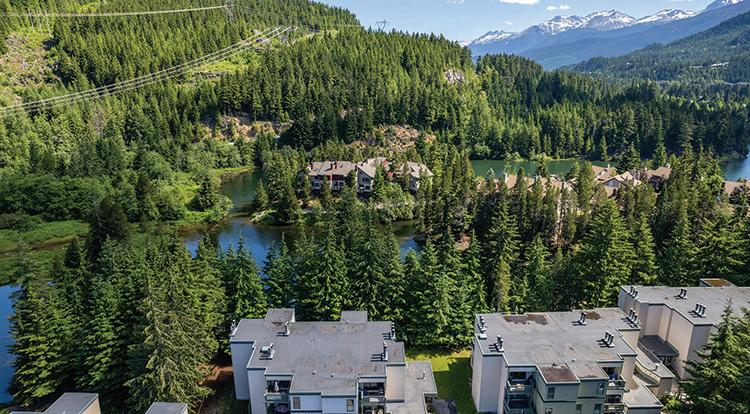
6693 Tapley Place “Serenity”
NORDIC
NORDIC

513 The Main
in the heart of
Squamish
all urban amenities and outdoor activities at your doorstep.



finishing’s, 9ft ceilings along with
make this building standout.
Angie Vazquez
style
Engel & Völkers
is a proud champion of Special Olympics Canada. Our Whistler Shop is committed to raising $10,000 this year during the fundraising event for 60 Minutes for Special Olympics

advisors and team members have pledged to spend 60 minutes as a Shop exercising to support our partner and their mission to create inclusive communities for children and adults with intellectual disabilities.
donate what you can as we work together to unleash the human spirit through the transformative power and joy of sports. Join us as we amplify the great work of Special Olympics Canada!

Main Street · Whistler


V8E 1A8
604-932-1875

